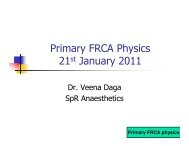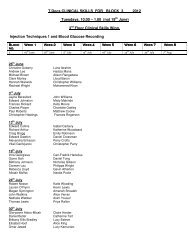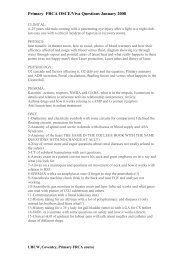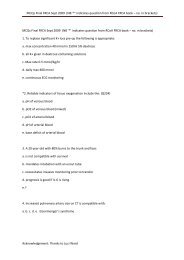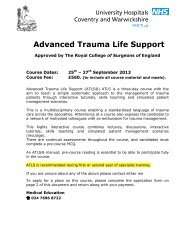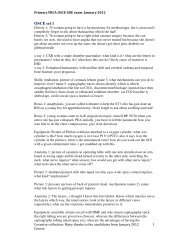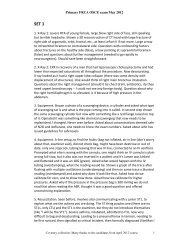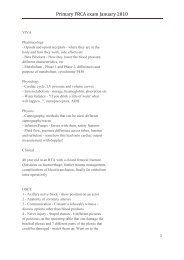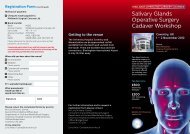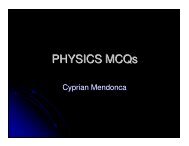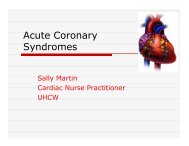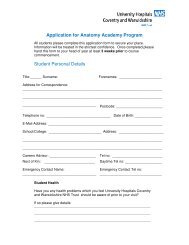Final FRCA VIVA December 2008 - MEDICAL EDUCATION at ...
Final FRCA VIVA December 2008 - MEDICAL EDUCATION at ...
Final FRCA VIVA December 2008 - MEDICAL EDUCATION at ...
You also want an ePaper? Increase the reach of your titles
YUMPU automatically turns print PDFs into web optimized ePapers that Google loves.
University Hospitals Coventry & Warwickshire NHS Trust: Dr C Mendonca<strong>Final</strong> <strong>FRCA</strong> viva: <strong>December</strong> <strong>2008</strong>Set 1Clinical Long Case:Elderly women for laparotomy perf bowel, with large neckswelling, presumed goitre. Has inspiritory stridor.Discuss ECG (AF), CXR (perf, cardiomegaly, mediastinalmass) and other investig<strong>at</strong>ions recommended. Fluidresuscit<strong>at</strong>ion, how to do fluid challenge etc. Method ofAFOI,Reason for polycythaemia. Discuss airway management.Critical incident fast AF. Post-op management of airway.Short cases:1. 15yr old with FB in eye, full stomach.2. Epidural trouble-shooting (ie called to ward, post APresection, epidural not working). Discuss sensory/motorblock aspects. Pain scales and pain assessment.3. Can't rememberSciences:1. An<strong>at</strong>omy of IJV2. Indic<strong>at</strong>ions and complic<strong>at</strong>ions of central venous access3. Adult and children daily fluid and electrolyterequirements, how much Na+ in different fluids4. Paedi<strong>at</strong>ric fluids, discuss causes and consequences ofhypon<strong>at</strong>raemia, SIADH etc5. Oxygen delivery - different facemasks how much %O2,Venturi effect, examples6. Oxygen sampling, draw and explain fuel cell andparamagnetic (old version). Write down actual reactionequ<strong>at</strong>ions (Pb, Gold, OH-, electrons etc)7. Cholinesterase - wh<strong>at</strong> different types are there. Thenacetylcholinesterase inhibitors. Wanted lots of detailabout syptoms and tre<strong>at</strong>ment of organophosophoruspoisoning.8. Suxamethonium apnoea - wanted r<strong>at</strong>ional behind dibucainenumber (quite detailed). How long the apnoea lasts for thevarious genotypesSet 2LONG CASE ( 8 TH DECEMBER <strong>2008</strong> )76 yr lady admitted 36 hrs ago with abdominal pain,nausea ,vomiting.She has beenresuscit<strong>at</strong>ed with i.v.fluids and nasogastric aspir<strong>at</strong>ion.31 yrs ago she had a sub-total thyroidectomy but the disease has recurred and she has adiffuse goitre.Thyroid function tests performed 2 yrs ago was normal.She is normally on 0.25mg digoxin and 300mg aspirin.O/EPulse 85/min irregularly irregularBP 130/55 mmHg1
University Hospitals Coventry & Warwickshire NHS Trust: Dr C MendoncaSwelling in the neckThe surgeon wants to perform a laparotomy for caecal perfor<strong>at</strong>ion.INVESTIGATIONSECG : AF r<strong>at</strong>e 75-85CXR : AP view – large mass in the neck, lung fields rel<strong>at</strong>ively clear ? minimal pleuraleffusionsHeart looked enlarged( cannot comment as AP view )BIOCHEMISTRY (normal) : Na 139 mmol/l K 3.9 mmol/l Urea 8.0 mmol/l Cre<strong>at</strong>inine108 umol/lFBC : Hb 15.9 g/dlPCV raisedWCC 17.9 X 10^9/ LQUESTIONSSummarise the caseComment on cxr findingsIs she adequ<strong>at</strong>ely resuscit<strong>at</strong>ed ? ( no-raised hb and pcv )Do you want to take her to the<strong>at</strong>re?How will you pre-optimise her?Wh<strong>at</strong> other inv do you want? ( ct scan, IDL,nasendoscopy ,thyroid function tests )How would you manage the airway ? (I settled on awake fibreoptic as the safest option )After securing the airway the choice of induction agent,muscle relaxant and maintenanceagent and why?In addition to cvp and art line wh<strong>at</strong> else would I like to monitor? ( said cardiac output withDoppler/ lidco)Wh<strong>at</strong> is lidco and how does it work? ( very briefly-nothing in too much detail )Wh<strong>at</strong> else to monitor ? ( urine output,peripheral perfusion,core-peripheral temp gradient )Intra-op pt develops AF with r<strong>at</strong>e of 160 and haemodynamic compromise-wh<strong>at</strong> would youdo? ( i said ideally DC cardioversion but need to rule out thrombus or anticoagul<strong>at</strong>e-ruledout in this case ...remember pt is only on digoxin without any anticoagul<strong>at</strong>ion and is inchronic AF normally—from history )So wh<strong>at</strong> would you do? ( amiadarone and dose )Wh<strong>at</strong> could be the reason for AF ?Causes of AF in general.After the surgery wh<strong>at</strong> factors would decide if I would extub<strong>at</strong>e the p<strong>at</strong>ient.Pros and cons of extub<strong>at</strong>ing v/s period of ventil<strong>at</strong>ion post-op.Methods of pain relief ( couldn’t complete – bell rang! )SHORT CASES1) 75 YR OLD WITH AORTIC STENOSIS FOR THR .Signs and symtoms of AS.Examin<strong>at</strong>ion findings.Investig<strong>at</strong>ions to assess severity of AS.Grading of severity on valve area and mean gradient.Cardiologist says doesn’t need valve replacement. Aims of anaesthetic management.How would you anaesthetise him?2) 15 YR OLD WITH PENETRATING EYE INJURY WITH FULL STOMACH.Wh<strong>at</strong> are the main concerns.Effect of sux on IOP – by how much does it increase it?2
University Hospitals Coventry & Warwickshire NHS Trust: Dr C MendoncaHow can you prevent it ?Wh<strong>at</strong> other option is available - delay surgery till fasted.Surgeon says cant wait- how will you anaesthetise ( I chose modified rapid sequence usingpropofol,rocuronium and alfentanil to prevent pressor response- examiner seemed ok with it.)Wh<strong>at</strong> are your aims in management ? ( usual stuff like prevent factors increasingiop,maintain normocarbia, adequ<strong>at</strong>e analgesia , prophylactic anti-emetics, extub<strong>at</strong>ion whenfully awake )How else can you anaesthetise- didn’t understand wh<strong>at</strong> the examiner was lookingfor.thankfully moved to next short case.3) PATIENT HAD PROCTOCOLECTOMY EARLIER THIS MORNING.EPIDURAL IN-SITU.LATER IN THE EVENING NURSE ON THE WARD CALLS YOU ( YOU AREON-CALL ) AND SAYS EPIDURAL NOT WORKING AND PT IN PAIN.How will you go about managing this.How do you assess the block?Wh<strong>at</strong> do you look for in the anaesthetic notes?Wh<strong>at</strong> do you look for <strong>at</strong> epidural site? ( c<strong>at</strong>heter slipped out, fluid around site)Wh<strong>at</strong> are the options available? ( couldn’t complete—bell rang to the rescue)Overall felt both the examiners were friendly and put me <strong>at</strong> ease . generally lookingfor common sense approach to problems than actual factual details. Helps very muchto have a calm mind and to think before answering. ( easier said than done! )GOOD LUCK TO EVERYBODY .Set 3CLINICAL:63 Year old lady with malignant melanoma on her back. For wide local excision and axillaryclearance in prone position. She had chronic cough and has been tre<strong>at</strong>ed 3x in the last yearwith antibiotics for recurrent chest infections. She has had a previous R mastectomy forbreast cancer 8 years ago. She also has a recent history of palpit<strong>at</strong>ions.Drugs: enalaprilO/E: Wt 54kg Ht 5 ft 5BP 160/105HR 80On examin<strong>at</strong>ion heart sounds normal. Chest bil<strong>at</strong>erally wheezy with widespread crackles.CXR: RLL consolid<strong>at</strong>ion and (I thought) effusion.ECG: SR but ectopics. LVH. Normal axis. No Q waves.Included:U+E:Na 137K 4.5U 10C 1573
University Hospitals Coventry & Warwickshire NHS Trust: Dr C MendoncaPFTs: FEV/FVC r<strong>at</strong>io 64% Post nebulised salbutamol 67%Reduced FEV1Reduced FVC: Obstructive.Summarise this case briefly.Wh<strong>at</strong> do you think about her CXR, ECG – went through both.LVH – likely cause.PFTs – reversibility/ causes: COPD, bronchitisRenal impairment and likely causes – ACEI and hypertensive nephrop<strong>at</strong>hy.Pre optimis<strong>at</strong>ion & other investig<strong>at</strong>ions (History, FBC, ABG, Ex Tol, ?CT chest)Wh<strong>at</strong> about her hypertension – wh<strong>at</strong> risk involved – would you proceed?How would you anaesthetise her? Wh<strong>at</strong> techniques? Monitoring? I said reinforced tube,positioning, eye padding, free abdomen.Problems with prone and wh<strong>at</strong> mode of ventil<strong>at</strong>ion and wh<strong>at</strong> pressures would I set ventil<strong>at</strong>or?Abdominal compartment syndrome.Wh<strong>at</strong> problems might the surgeons cause you? I said methylene blue and rib resection. Thenproblems with meth blue?Pain relief? I said PCA Morphine as proximity to surgical site/ infection risk with epidural.Mentioned DVT prophylaxis and then asked about guidelines – NICE and theirrecommend<strong>at</strong>ions.Post-op she is extub<strong>at</strong>ed and goes to recovery; she becomes hypoxic and wheezy – take methrough your management. ABC, ensure no AW obstruction & give oxygen. Listen to chest –give B2 agonists. Etc etcThen differentials: main thing they wanted: post-op <strong>at</strong>electasis with V/Q mism<strong>at</strong>ch.How would I manage: I said resp supprt NIV, CPAP, and physio.SHORT cases:1. Dural puncture: wh<strong>at</strong> do you do & how do you manage? I put spinal c<strong>at</strong>heter andmentioned explicit risk and precautions needed. Then explain and reassure woman.L<strong>at</strong>e management and differentials.Bld p<strong>at</strong>ch & risks and % resolution.2. 60yr old man with severe cardiac history: 2 stents for knee arthroscopy.How would you manage?Assessment, wh<strong>at</strong> investig<strong>at</strong>ions. Started with history, ECG, CPET. Showed me ECG:Inferior Q waves and l<strong>at</strong>eral deep T inversion. Nomal axis but LVH.Post-MI risk – asked for % risk of peri-op MI – mentioned guidelines ACC.Wh<strong>at</strong> anaesthetic – I said regional ideal: Lumbar plexus block or femoral/ sci<strong>at</strong>ic.Wh<strong>at</strong> complic<strong>at</strong>ions of LA blocks in general.3. 8 yr old boy – found in ditch. Comes to A&E with open fractured tib/fib. Wh<strong>at</strong> do youdo?ABC – C spine control. APLS. Assessments of conscious level – GCS and AVPU.Signs of HI & indic<strong>at</strong>ions for CT head – guidelines again AAGBI, NICE.Raised ICP and management – risks and wh<strong>at</strong> to avoid – time to draw 1 graph but notime for much detail. CPP.SCIENCE viva:4
University Hospitals Coventry & Warwickshire NHS Trust: Dr C Mendonca1. An<strong>at</strong>omy: Phrenic nerve.Where and by wh<strong>at</strong> could it be damaged along its course. Take me through each level& mechanism.Course neck and thorax, diaphragm– after explaining course asked specifically wheredoes it lie in the chest.Phrenic nerve damange – how would you tell? Wh<strong>at</strong> would happen? FRC,paradoxical mov. Why might this be bad and whom particularly <strong>at</strong> risk.Tests to confirm – end insp CXR. Wh<strong>at</strong> else? Made up sniffing while visualising withUS!2. Indic<strong>at</strong>ions for renal replacement. Specifics about uraemia, when and wh<strong>at</strong> level RRTindic<strong>at</strong>ed.K and wh<strong>at</strong> level.Methods of renal replacement and adv/disadv of each. HD, HF, PD. Physicalprinciples.Risks involved: c<strong>at</strong>heter rel<strong>at</strong>ed and procedure rel<strong>at</strong>ed. Specifics of anticoagul<strong>at</strong>ion.Mortality benefit and do I know of any trials. Cytokines.3. Very strangely phrased Q: Scenario and end of oper<strong>at</strong>ion, after using VEC, there is noTOF.Causes of no TOF stimul<strong>at</strong>ion- Basically wanted wh<strong>at</strong> prolongs blockade, but veryunclear <strong>at</strong> 1 st ! Drugs, electrolytes, NM disease, neurop<strong>at</strong>hy & equipment factorsAll NM monitoring, types, mechanism – T4:T1 r<strong>at</strong>io, stimului types, current etc.4. Wh<strong>at</strong> groups of p<strong>at</strong>ients are <strong>at</strong> risk if you don’t humidify AW gases & why? Groups.Short-term & longterm damage and sequelae. Types of humidific<strong>at</strong>ion. Passive HME& l<strong>at</strong>ent he<strong>at</strong> vaporis<strong>at</strong>ion. Active: Mentioned Bernoulli principle & USS then bellrang.Set 4LONG CASE ( 8 TH DECEMBER <strong>2008</strong> )76 yr lady admitted 36 hrs ago with abdominal pain,nausea ,vomiting.She has beenresuscit<strong>at</strong>ed with i.v.fluids and nasogastric aspir<strong>at</strong>ion.31 yrs ago she had a sub-total thyroidectomy but the disease has recurred and she has adiffuse goitre.Thyroid function tests performed 2 yrs ago was normal.She is normally on 0.25mg digoxin and 300mg aspirin.O/EPulse 85/min irregularly irregularBP 130/55 mmHgSwelling in the neckThe surgeon wants to perform a laparotomy for caecal perfor<strong>at</strong>ion.INVESTIGATIONSECG : AF r<strong>at</strong>e 75-85CXR : AP view – large mass in the neck,lung fields rel<strong>at</strong>ively clear ? minimal pleuraleffusionsHeart looked enlarged( cannot comment as AP view )BIOCHEMISTRY (normal) : Na 139 mmol/l K 3.9 mmol/l Urea 8.0 mmol/l Cre<strong>at</strong>inine108 umol/lFBC : Hb 15.9 g/dl5
University Hospitals Coventry & Warwickshire NHS Trust: Dr C MendoncaPCV raisedWCC 17.9 X 10^9/ LQUESTIONSSummarise the caseComment on cxr findingsIs she adequ<strong>at</strong>ely resuscit<strong>at</strong>ed ? ( no-raised hb and pcv )Do you want to take her to the<strong>at</strong>re?How will you pre-optimise her?Wh<strong>at</strong> other inv do you want? ( ct scan, IDL,nasendoscopy ,thyroid function tests )How would you manage the airway ? (I settled on awake fibreoptic as the safest option )After securing the airway the choice of induction agent,muscle relaxant and maintenanceagent and why?In addition to cvp and art line wh<strong>at</strong> else would I like to monitor? ( said cardiac output withDoppler/ lidco)Wh<strong>at</strong> is lidco and how does it work? ( very briefly-nothing in too much detail )Wh<strong>at</strong> else to monitor ? ( urine output,peripheral perfusion,core-peripheral temp gradient )Intra-op pt develops AF with r<strong>at</strong>e of 160 and haemodynamic compromise-wh<strong>at</strong> would youdo? ( i said ideally DC cardioversion but need to rule out thrombus or anticoagul<strong>at</strong>e-ruledout in this case ...remember pt is only on digoxin without any anticoagul<strong>at</strong>ion and is inchronic AF normally—from history )So wh<strong>at</strong> would you do? ( amiadarone and dose )Wh<strong>at</strong> could be the reason for AF ?Causes of AF in general.After the surgery wh<strong>at</strong> factors would decide if I would extub<strong>at</strong>e the p<strong>at</strong>ient.Pros and cons of extub<strong>at</strong>ing v/s period of ventil<strong>at</strong>ion post-op.Methods of pain relief ( couldn’t complete – bell rang! )SHORT CASES1) 75 YR OLD WITH AORTIC STENOSIS FOR THR .Signs and symtoms of AS.Examin<strong>at</strong>ion findings.Investig<strong>at</strong>ions to assess severity of AS.Grading of severity on valve area and mean gradient.Cardiologist says doesn’t need valve replacement. Aims of anaesthetic management.How would you anaesthetise him?2) 15 YR OLD WITH PENETRATING EYE INJURY WITH FULL STOMACH.Wh<strong>at</strong> are the main concerns.Effect of sux on IOP – by how much does it increase it?How can you prevent it ?Wh<strong>at</strong> other option is available - delay surgery till fasted.Surgeon says cant wait- how will you anaesthetise ( I chose modified rapid sequence usingpropofol,rocuronium and alfentanil to prevent pressor response- examiner seemed ok with it.)Wh<strong>at</strong> are your aims in management ? ( usual stuff like prevent factors increasingiop,maintain normocarbia, adequ<strong>at</strong>e analgesia , prophylactic anti-emetics, extub<strong>at</strong>ion whenfully awake )How else can you anaesthetise- didn’t understand wh<strong>at</strong> the examiner was lookingfor.thankfully moved to next short case.6
University Hospitals Coventry & Warwickshire NHS Trust: Dr C Mendonca3) PATIENT HAD PROCTOCOLECTOMY EARLIER THISMORNING.EPIDURAL IN-SITU.LATER IN THE EVENING NURSE ON THEWARD CALLS YOU ( YOU ARE ON-CALL ) AND SAYS EPIDURAL NOTWORKING AND PT IN PAIN.How will you go about managing this.How do you assess the block?Wh<strong>at</strong> do you look for in the anaesthetic notes?Wh<strong>at</strong> do you look for <strong>at</strong> epidural site? ( c<strong>at</strong>heter slipped out, fluid around site)Wh<strong>at</strong> are the options available? ( couldn’t complete—bell rang to the rescue)Overall felt both the examiners were friendly and put me <strong>at</strong> ease . generally lookingfor common sense approach to problems than actual factual details. Helps very muchto have a calm mind and to think before answering. ( easier said than done! )GOOD LUCK TO EVERYBODY .BASIC SCIENCE <strong>VIVA</strong> ( 8 TH DECEMBER <strong>2008</strong> )ANATOMYIndic<strong>at</strong>ions for central venous cannul<strong>at</strong>ion.An<strong>at</strong>omy of IJV and SUBCLAVIAN VEIN –in quite some depth.Complic<strong>at</strong>ions of central venous cannul<strong>at</strong>ion.Methods of cannul<strong>at</strong>ing.Pros and cons of ultrasound and landmark techniques.PHYSIOLOGYFluid requirements of 6 yr old child.Na and K requirements.Wh<strong>at</strong> type of fluids and why?Wh<strong>at</strong> is stress response to surgery ?Why do children need glucose containing fluids ?Wh<strong>at</strong> are the problems of giving only glucose?Effects of hypon<strong>at</strong>remia .PHARMACOLOGYWh<strong>at</strong> is acetylcholinesterase ?Where is it found ? how does it work ?Wh<strong>at</strong> is pseudocholinesterase? Other name for it ?Where is it found ?Wh<strong>at</strong> other drugs apart from sux does it metabolise?N<strong>at</strong>ural cause of decreased pseudocholinesterase production ?Genetic variability ,dibucaine no and fluoride no .PHYSICSMethods of o2 delivery to pt .Fixed performance and variable systems.Principle of venturi-mask.A bit about Hudson mask and o2 tents.Measurement of o2 - fuel cell , paramagnetic analyser.Again felt examiners were very friendly. In this viva you need a bit of luck to getasked about wh<strong>at</strong> you know well. Th<strong>at</strong> builds up the initial confidence and the rest ofthe viva can go well.Other candid<strong>at</strong>es got asked about an<strong>at</strong>omy of phrenic nerve, renal replacementtherapies, humidity and methods of humidific<strong>at</strong>ion and muscle relaxants .7
University Hospitals Coventry & Warwickshire NHS Trust: Dr C MendoncaTHANK GOD ITS ALL OVER . AS YOU MIGHT HAVE GUESSED I PASSED.Set 5Long Case.30ish old man130 KG Mallamp<strong>at</strong>ti 3Poorly controlled epileptic refractory to quad drug therapyKeppraCarbamazepine2 benzodiazepinesInvesig<strong>at</strong>ionsCXRVagal nerve stimul<strong>at</strong>orSleep studiesOSAPolycythaemiaLung function testsPEFR ↓No reversibility givenPresentes with ruptured globe following fall on to radi<strong>at</strong>or, no recollection of events.Discuss management and investig<strong>at</strong>ionsShort CasesStridor in childLaproscopic surgeryPhysiological changesComplic<strong>at</strong>ionsX-ray caseTB – right upper lobe collapseNeeds urgent surgery for bleeding ectopicHypotensiveResusitive laparotomyHDU post opTB implic<strong>at</strong>ions side room etc8
University Hospitals Coventry & Warwickshire NHS Trust: Dr C MendoncaBasic sciencesPharmacologyMechanisms – (detailed) of excretion by kidneyAffect of renal failure on pharmacokineticsPhysicsTemper<strong>at</strong>ures measurementCauses of hyperthermiaPhysiology of pregenancyManagement of pregnant lady with appendicitisAn<strong>at</strong>omySymp<strong>at</strong>hetic nervous systemSet 6My Questions:Long case: 72 yr Known lung tumor. Comes to A&E with severe pain in the neck. with ASmurmer.Cspice l<strong>at</strong>eral view. C2 mass with A/A sublux<strong>at</strong>ion. ECG Lt axis and borderline LVH2Decho AS gradient 35mmhg.discussion went to c-spine fix<strong>at</strong>ion and awake fibreoptic and anaesthetic management. andneurological complic<strong>at</strong>ion and examin<strong>at</strong>ion.short cases.1 Jehovah's witness.2 preeclamtic. anaesthesia for C/S pros and cons of GA/Spinal and periop management3. Pt who had a tracheostomy 4 days ago starts bleeding from tracheostomy site. how wouldyou manage. causes of bleeding <strong>at</strong> 4 days. The tracheostomy gets dislodged when taking thep<strong>at</strong>ient to the<strong>at</strong>re in the corridor how would you manage.basic science viva.Vagus nerve transection <strong>at</strong> jugular foraman. unil<strong>at</strong>eral and bil<strong>at</strong>eral. they were only interestedin airway problems an<strong>at</strong>omy, nerve supply etc. discussion also included thyroidectomy. andcomplic<strong>at</strong>ions.Beta receptors everything and B blockers. Recent public<strong>at</strong>ions regarding b blocker uses,,recommend<strong>at</strong>ions.plenun system and uses in anaesthetics. other than vaporisers.l<strong>at</strong>ex allergy. how long does l<strong>at</strong>ex last in the the<strong>at</strong>re in general exponential decay etcSet 71 A 25 years old lady is brought to A&E unconscious after an overdose of drugs.How will you assess her?How do you assess consciousness?At wh<strong>at</strong> level of GCS would you intub<strong>at</strong>e her?She had alcohol and Paracetamol, how will you manage her ( airway & bre<strong>at</strong>hing is fine)?When will you give her N acetyl cysteine?Wh<strong>at</strong> is the route of administr<strong>at</strong>ion?9
University Hospitals Coventry & Warwickshire NHS Trust: Dr C MendoncaIn which solution is it prepared?Which organs are affected by Paracetamol toxicity?Wh<strong>at</strong> is the p<strong>at</strong>hophysiology of hep<strong>at</strong>ic toxicity?If the INR is high wh<strong>at</strong> would you do?2 A 45 year old male p<strong>at</strong>ient for a testicular oper<strong>at</strong>ion wants an epidural for the oper<strong>at</strong>ion. Hewas very groggy with his last GA and donot want GA.Wh<strong>at</strong> will you say to him?Wh<strong>at</strong> risks of Spinal/epidural would you explain to him?Innerv<strong>at</strong>ion of testies?Risk of pain in regional anaesthetic in teticular surgery?3 A man with Pacemaker for an elective surgery.Routine viva bookcasePacemaker codePreop checkDi<strong>at</strong>hermyElectrical safetyClinical Sciences Viva1 An<strong>at</strong>omy of noseIndic<strong>at</strong>ions of nasal intub<strong>at</strong>ion.Risks of nasal intub<strong>at</strong>ion.How can you anaesthetise nose?How much lignocaine can be used?How much lignocaine is there in a puff?2 Hyperbaric OxygenMechanism of actionIndic<strong>at</strong>ionsCarbon monoxide poisoining ; Criteria for HOTLevels of CO normal/ abnormalP<strong>at</strong>hophysiology of CO poisoningSymptomsContraindic<strong>at</strong>ions3 SuxamethoniumMechanism of actionMyalgia – reasonHow can you prevent myalgia?Metabolism of SuxPseudocholinesterase deficiency – genetic variabilityOther causes10
University Hospitals Coventry & Warwickshire NHS Trust: Dr C MendoncaTypes of allelesDibucaine number4 Foetal circul<strong>at</strong>ionDraw & explain.Changes <strong>at</strong> birth.Which drug is used to cause ductus arteriosus closure in babies?Which drug is used to reduce pulmonary hypertension?Wh<strong>at</strong> is tetralogy of Fallot?Wh<strong>at</strong> will the anaesthetic consider<strong>at</strong>ions in management of TOF?Set 8Long case:80 yr old lady for laparoscopic repair of hi<strong>at</strong>us hernia with a history of nausea and vomittingfor some time. Anaemic (Hb - 9 normocytic), Albumin - 22, Low magnesium and calcium,significant ischemic changes on her ECG and a large homogenous opacity continuous withher heart shadow and diaphragm in the left lower zone on the Chest x ray. She was ondigoxin and a diuretic and was diagnosed with Atrial fibrill<strong>at</strong>ion in the past.QuestionsSummariseDiscussion on investig<strong>at</strong>ions and results:wh<strong>at</strong> could be the reasons for low calcium and magnesium? would you correct it pre-opwh<strong>at</strong> could be the reasons for anemia? would you correct itWh<strong>at</strong> could be the reasons for low albumin in her? would you correct itWh<strong>at</strong> are the changes in ECG? wh<strong>at</strong> is your diagnosis ( Q waves in L2 and AvF, andextensive T wave changes in all leads)Wh<strong>at</strong> do you think is the cause for the shadow? Wh<strong>at</strong> are the differentials? How wouldyou confirm.Wh<strong>at</strong> other investig<strong>at</strong>ions do you want and why?How long will you wait before anaesthetising her?Wh<strong>at</strong> anaesthetic technique?Wh<strong>at</strong> pain management?Wh<strong>at</strong> other post oper<strong>at</strong>ive mangement? HDU/ITUWill she need ITU, if so why?Then we spoke on Nutrition in the ITU, advantages/disadvantages and differences betweenenteral and parenteral nutrition.Short case:Post tonsillectomy bleed..... standard questions rel<strong>at</strong>ing to assessment of blood loss,resuscit<strong>at</strong>ion and management.Atrial flutter and its management.An<strong>at</strong>omy:1. An<strong>at</strong>omy of trachea and how the an<strong>at</strong>omy affects an aspir<strong>at</strong>ed foreign body in an adult.( extent, rel<strong>at</strong>ions - both intra and extra thoracic, bronchopulmonary segments. managementof anaesthesia for a foreign body.11
University Hospitals Coventry & Warwickshire NHS Trust: Dr C Mendonca2. Cigarrette smoking and its effects: Nicotine, Carbon monoxide, carcinogens, changes tothe cilia, COPD etc etc. Wh<strong>at</strong> are the effects of stopping smoking? How long would youadvise a chronic smoker to stop smoking before anaesthesia3. Pharmacology: Effects of drugs on ICP: started off from induction agents to all other drugsth<strong>at</strong> we use in the<strong>at</strong>re.4. Laser: How is laser produced? and all the standard questions from the basic sciences vivabook..Set 9Clinical long case28 year old primi gravida, 7 hours after an emergency LSCS needs a laparotomy massivePPH. She is tachycardic, BP unrecordable, pale and anxious. Lab results show severeanaemia, coagulop<strong>at</strong>hy, pre renal dysfunction. Blood transfusion is in progressDiscussion was based on resuscit<strong>at</strong>ion, blood products, factor 7A, and anaesthesia inhaemodyanmically unstable p<strong>at</strong>ient.Few questionsWh<strong>at</strong> Hb are you happy with?Wh<strong>at</strong> induction agent, why?Problems with massive transfusion?Wh<strong>at</strong> are the ways to control PPH? Esp <strong>at</strong>onic PPHRisk factors for <strong>at</strong>onic PPHUterine tonics?Surgical ways to control bleeding?Systemic problems with massive transfusion?Post op complic<strong>at</strong>ions?Showed an xray of ards wh<strong>at</strong> could this be if it develops within 12 hours ITU admission?TRALI/overload…discussion on trailPost op renal failure: how to manageClinical short cases1. Showed an ECG of AF with ventricular r<strong>at</strong>e of 90, old inferior wall MI , LAD70 year old male for cystoscopyclinical correl<strong>at</strong>ion? How to optimise, wwhen would you anaesthetise? Shock or chemicalcardiovertion? Different scenarios.Causes of AF?Drugs used?Intraoper<strong>at</strong>ive fast AF, how to manage2. 80 M k/o COPD with acute exacerb<strong>at</strong>ioncauses of deterior<strong>at</strong>ion?Any i<strong>at</strong>rogenic causes? O2 therapy , its mechanism12
University Hospitals Coventry & Warwickshire NHS Trust: Dr C MendoncaHow to assess the p<strong>at</strong>ient, investig<strong>at</strong>ions?Tre<strong>at</strong>mentWh<strong>at</strong>s blue blo<strong>at</strong>er and pink puffers?Who is suitable for NIV? Wh<strong>at</strong> are the contraindic<strong>at</strong>ions?When would you think of ventil<strong>at</strong>ing?Problems with weaning3. IVDU for Hickman line insertionWh<strong>at</strong> are the perioper<strong>at</strong>ive problems? Vascular access/infections/Issues of pain controlViral diseases he can have?this p<strong>at</strong>ient has aids, and you get a needle stick injurywh<strong>at</strong> is the protocolbasic science viva1. Carotid endarterectomyAnaesthetic options advantages, disaadv.Superficial c plexus block how to perform, why not deep?Wh<strong>at</strong> are the complic<strong>at</strong>ions of deep blockWh<strong>at</strong> are the monitors usedHaws is cerebral function monitored in awake p<strong>at</strong>ients2Differences in neon<strong>at</strong>al resp physiology and their anaesthetic implic<strong>at</strong>ionsCongenital diaphragm<strong>at</strong>ic hernias, p<strong>at</strong>hophysiology , how to optimise, ventil<strong>at</strong>ory str<strong>at</strong>egy3. At the end of a long oper<strong>at</strong>ion in which there was a blood loss of 5 litres the wound edgesare oozy…wh<strong>at</strong> the mechanism isDiscussion on cell based coagul<strong>at</strong>ion, replacement of factors, wh<strong>at</strong> when how much to givewh<strong>at</strong> are the test used to assess coagul<strong>at</strong>ion, bed side tests? TEG in detail4. Arterial blood pressure trace? Wh<strong>at</strong> info can you g<strong>at</strong>her from the trace?Wh<strong>at</strong> happens to the position of dicrotic notch in raised svr? I said it would be shiftedproximally on the down slope…he seemed to agreeHow does a line monitor work?Wh<strong>at</strong> are the sources of error resonance, dampingSet 10Long caseA 23 year old female who has delivered 7 hrs ago LSCS - continuing to pass clots onsyntocinon infusion, large baby weight - 4.5 kgs failure to progress prolonged labour . She isrecieving bloods. Surgeons want to take her up for explor<strong>at</strong>ory laparotomypale anxious HR -140/min BP unrecordableHb - pre LSCS 13.2 g/l post 2.5 9/lPl<strong>at</strong>elets pre 373 post 7313
University Hospitals Coventry & Warwickshire NHS Trust: Dr C MendoncaD Dimer - 6 ( very high)Fibrinogen - NormalCan you summarise the case ?Wh<strong>at</strong> is going on in your mind as you go to see her ?Wh<strong>at</strong> is the first thing you do ? ( apparently speed up the infusion)Wh<strong>at</strong> are the causes for her bleeding ?Wh<strong>at</strong> is your management ?Wh<strong>at</strong> are the doses of syntocinon, ergometrine and carboprost ?Where will you take her post op ?Sown X ray - ? ARDS / TRALIWh<strong>at</strong> is your post op management ?Short cases:1. ECG - AF Causes, coming in for cystoscopy <strong>at</strong> induction BP crashes wh<strong>at</strong> drug would youuse ?2. IV drug abuser - precautions, difficulties , needle stick injury, incidence of HIV positivityafter needle stick, post exposure prophylaxis3. Elderly male COPD called by chest physician how will you asess ? when will you manageconserv<strong>at</strong>ively ? Quality of lifeClinical Viva:1. Intra arterial pressure monitoring - indic<strong>at</strong>ions, damping , resonance, wh<strong>at</strong> parameters arederived, draw a trace, complic<strong>at</strong>ions of arterial puncture,2. GA Versus LA carotid endarterectomy - how do you do deep and superficial cervicalplexus block, complic<strong>at</strong>ions Local versus GA3. compare and contrast neon<strong>at</strong>al versus adult physiologyClinical long case28 year old primi gravida, 7 hours after an emergency LSCS needs a laparotomy massivePPH. She is tachycardic, BP unrecordable, pale and anxious. Lab results show severeanaemia, coagulop<strong>at</strong>hy, pre renal dysfunction. Blood transfusion is in progress14
University Hospitals Coventry & Warwickshire NHS Trust: Dr C MendoncaDiscussion was based on resuscit<strong>at</strong>ion, blood products, factor 7A, and anaesthesia inhaemodyanmically unstable p<strong>at</strong>ient.Few questionsWh<strong>at</strong> Hb are you happy with?Wh<strong>at</strong> induction agent, why?Problems with massive transfusion?Wh<strong>at</strong> are the ways to control PPH? Esp <strong>at</strong>onic PPHRisk factors for <strong>at</strong>onic PPHUterine tonics?Surgical ways to control bleeding?Systemic problems with massive transfusion?Post op complic<strong>at</strong>ions?Showed an xray of ards wh<strong>at</strong> could this be if it develops within 12 hours ITU admission?TRALI/overload…discussion on trailPost op renal failure: how to manageClinical short cases1. Showed an ECG of AF with ventricular r<strong>at</strong>e of 90, old inferior wall MI , LAD70 year old male for cystoscopyclinical correl<strong>at</strong>ion? How to optimise, wwhen would you anaesthetise? Shock or chemicalcardiovertion? Different scenarios.Causes of AF?Drugs used?Intraoper<strong>at</strong>ive fast AF, how to manage2. 80 M k/o COPD with acute exacerb<strong>at</strong>ioncauses of deterior<strong>at</strong>ion?Any i<strong>at</strong>rogenic causes? O2 therapy , its mechanismHow to assess the p<strong>at</strong>ient, investig<strong>at</strong>ions?Tre<strong>at</strong>mentWh<strong>at</strong>s blue blo<strong>at</strong>er and pink puffers?Who is suitable for NIV? Wh<strong>at</strong> are the contraindic<strong>at</strong>ions?When would you think of ventil<strong>at</strong>ing?Problems with weaning3. IVDU for Hickman line insertionWh<strong>at</strong> are the perioper<strong>at</strong>ive problems? Vascular access/infections/Issues of pain controlViral diseases he can have?this p<strong>at</strong>ient has aids, and you get a needle stick injurywh<strong>at</strong> is the protocolbasic science viva15
University Hospitals Coventry & Warwickshire NHS Trust: Dr C Mendonca1. Carotid endarterectomyAnaesthetic options advantages, disaadv.Superficial c plexus block how to perform, why not deep?Wh<strong>at</strong> are the complic<strong>at</strong>ions of deep blockWh<strong>at</strong> are the monitors usedHaws is cerebral function monitored in awake p<strong>at</strong>ients2Differences in neon<strong>at</strong>al resp physiology and their anaesthetic implic<strong>at</strong>ionsCongenital diaphragm<strong>at</strong>ic hernias, p<strong>at</strong>hophysiology , how to optimise, ventil<strong>at</strong>ory str<strong>at</strong>egy3. At the end of a long oper<strong>at</strong>ion in which there was a blood loss of 5 litres the wound edgesare oozy…wh<strong>at</strong> the mechanism isDiscussion on cell based coagul<strong>at</strong>ion, replacement of factors, wh<strong>at</strong> when how much to givewh<strong>at</strong> are the test used to assess coagul<strong>at</strong>ion, bed side tests? TEG in detail4. Arterial blood pressure trace? Wh<strong>at</strong> info can you g<strong>at</strong>her from the trace?Wh<strong>at</strong> happens to the position of dicrotic notch in raised svr? I said it would be shiftedproximally on the down slope…he seemed to agreeHow does a line monitor work?Wh<strong>at</strong> are the sources of error resonance, dampingLong Case28 female, primi. Now 7 hours Post LSCS (for failure to progress)She had oxytocin drips for 5 hours before delivary.Delivered 4.8 kg male baby. She looks Unwell, pale,HR -140, BP not recordable, Carotid pulse presentPosted for urgent laprotomyPre LSCSNowHB 136 28PLAT 200 82PT - 18APTT - 76FIBRINOGEN 1.8Rest bloods OkSummary. Asked to go through blood results. Wh<strong>at</strong> it is?- severe haemorrhagic shock.Causes?Why Atony suggested in this case? Management? ABC, BLOOD, O NEGATIVE,BIMANUAL, INFORM VARIOUS PROFESSIONALS, SENIORS, ITU etc..Other blood products? Monitors? When happy to Induce for laprotomy? Wh<strong>at</strong> drugs forinduction- I said Ketamine. To ituIn ITU Chest Xray – shows pul odema and ett endobronchial. Why pul odema? How to tre<strong>at</strong>pul odema here? Wh<strong>at</strong> Other generic measures in ITU? Why DVT and GI prophylaxisneeded in this p<strong>at</strong>ient? Wh<strong>at</strong> are the measures of organ perfusion?When she is extub<strong>at</strong>ed, wh<strong>at</strong> pain management?16
University Hospitals Coventry & Warwickshire NHS Trust: Dr C MendoncaWhen can she breast feed?Short Case- Clinical1. 70 MALE for day case TURBT. HTN, plays golfECG- read through it? Wh<strong>at</strong>s callibr<strong>at</strong>ion? It was AF. Fe<strong>at</strong>ures on ECGCauses? He wanted IHD/HTN/VALVULAR DISEASE AND THYROTOXICOSIS]Wh<strong>at</strong> to do? P<strong>at</strong>ient has no symptoms? Post pone? Yes?- speak to cardiologistAfter few days, AF sorted. Introp- sudden HYPOTENSION? Causes?Not in AF. Wh<strong>at</strong>s inotrope of choice?2. Young male/IVDU/AIDS/for Hickmans lineIssues?? why infection in IVDU?Problems- Needle stick injury- Wh<strong>at</strong>s risk of AIDS infection? Factors governing the r<strong>at</strong>e?How compared to HbsAg? FIRST AID HOW? Then-occ health. Post exposure prophylaxiswh<strong>at</strong>drugs?Clinical Science Viva1. carotid enarterectomy -LA describe how? Wh<strong>at</strong> derm<strong>at</strong>omes blocked? Complic<strong>at</strong>ionsof block? Adv and disadv of LA. If needs GA , wh<strong>at</strong> major issues? How monitor CBFunder GA? WHAT problem post op? Incidence of stroke? It seems carotid stenosiscauses 20% of all the Stroke in any popul<strong>at</strong>ion. I guessed it to perfection2. Respir<strong>at</strong>ory Physiology of neon<strong>at</strong>e? How diff than adults? Chest wall, ribs, capacities,diaphragm, alveoli, etc. How control different? Said about chemorecptor lesssensetive???airway differences? Wanted oblig<strong>at</strong>e nose-bre<strong>at</strong>hers.Cong Diaghpram<strong>at</strong>ic hernia, wh<strong>at</strong> is it? Wh<strong>at</strong>s problem? Incidence? Present<strong>at</strong>ion? Principlesof Management of anaesthesia?3. Prolonged oper<strong>at</strong>ion, post op oozing from canula site- Causes. Wanted DIC,hypothermia, Liver damage, hypocalcemia, sepsis, drugs like nsaid, heparinInvestig<strong>at</strong>ions? Briefly each and which part of coagul<strong>at</strong>ion p<strong>at</strong>hway tested?Asked about TEG. How the test is done. Draw a normal and one abnormal trace?Wh<strong>at</strong> blood products can be given to correct coag problems? Wh<strong>at</strong> drugs, and how theywork?Transfusion triggers for pl<strong>at</strong>, cryo, rbc, factor 8 concentr<strong>at</strong>es?4. IABP- indic<strong>at</strong>ions? Complic<strong>at</strong>ions.? Draw a pulse trace? Wh<strong>at</strong> all inform<strong>at</strong>ion?Wanted a lot of stuff here..for stroke volume, clearly indic<strong>at</strong>e which part of area under the curve( upto diacrotic notch).Wh<strong>at</strong> is transducer? Problems with them?Long case63 year old female is posted for elective procedure of excision of malignant melanoma andgrafting.She is a hypertensive on tre<strong>at</strong>ment with enalapril 10 mg odShe has been a smoker for 30 years and in the last year has been tre<strong>at</strong>ed for chest infectionswith antibiotics 4 to 5 times.On examin<strong>at</strong>ion pulse 70 per minute regular. Blood pressure 170/105She has wide spread wheeze and crackles <strong>at</strong> the bases on auscult<strong>at</strong>ion17
University Hospitals Coventry & Warwickshire NHS Trust: Dr C MendoncaInvestig<strong>at</strong>ionsBiochemistrySodium 135Potassium 4.5Urea 10Cre<strong>at</strong>inine 130No other blood investig<strong>at</strong>ions like FBC were providedA set of spirometry results which showed a FEV 1/ FRC of 62% and 67% postbronchodil<strong>at</strong>or therapyAn ECG which showed a few ventricular prem<strong>at</strong>ure complexes and a LVH by voltage criteriaA chest x-ray which showed a loss of air shadowing in the rt base + right costophreinc angleobliter<strong>at</strong>ion. It showed a cardiomegalyQuestionsTell me about your caseTell me about the blood tests. Are the results standard or are they adjusted to the p<strong>at</strong>ient’scharacteristics (age sex etc)?Tell me about the ECGTell me about the x rayWh<strong>at</strong> about the spirometry results? Are these results adjusted to p<strong>at</strong>ient characteristics? Is theimprovement after bronchodil<strong>at</strong>or therapy significant?I had mentioned investig<strong>at</strong>ions and optimis<strong>at</strong>ion in my summary. He then said lets say yourp<strong>at</strong>ient is optimised and now ready for surgery .Wh<strong>at</strong> is your anaesthetic plan.I mentioned preop visit and premedic<strong>at</strong>ionWhy premed? Is it your normal practice? Why particularly in this p<strong>at</strong>ient then?I went on to checking machine drawing drugs etc..Etc… He said it is all done talk thro youranaestheticAfter I mentioned arterial line –Why arterial line? And induction and intub<strong>at</strong>ion withreinforced endotracheal tube, we moved on to prone positioningHow will you physically do the positioning? Number of people, how will you turn, how willyou position head, protect eyes and nervesPostoper<strong>at</strong>ively the p<strong>at</strong>ient develops wheezing and hypoxia in PACU. How will youmanage?Would you send this p<strong>at</strong>ient to HDU / ITU?Bell….Short casesYou have done a dural puncture with a 16 gauge needle in obstetrics. How will you proceed?I mentioned our hospital protocol of subarachnoid c<strong>at</strong>heter. Wh<strong>at</strong> drug will you give? Howlong will it act for? Wh<strong>at</strong> will you tell the midwives?Is there anything else you can do? Try another space. Wh<strong>at</strong> are the advantages anddisadvantages of c<strong>at</strong>heter and trying another space?Wh<strong>at</strong> will you do during follow up?If she has head ache how will you diagnose a post dural puncture headache from othercauses?How will you tre<strong>at</strong>- conserv<strong>at</strong>ive and then blood p<strong>at</strong>chHow will you do a blood p<strong>at</strong>ch?Wh<strong>at</strong> filter will you use to inject the blood? I said I have seen 2 of my consultants performingblood p<strong>at</strong>ch and we did not use a filter.18
University Hospitals Coventry & Warwickshire NHS Trust: Dr C Mendonca2. 54 year old weighing 107 kilogrammes , hypertensive is coming in for a knee arthroscopyECG given showed t wave inversion in lead1 , aVL and V3, V4, V5, V6. There were Qwaves in Lead 2 and aVFThe questions which followed were a bit vagueTell me about ECGWh<strong>at</strong> do your findings indic<strong>at</strong>e? I said IHD.Would you do any further investig<strong>at</strong>ions? Wh<strong>at</strong> else you can ask? I said exercise tolerance inhistory.Would you do this as a day case? I said you mentioned only the weight I need to find out theBMI. If obese I would not do this as day case because of the co morbidities.3. 8 year old boy RTA with fracture tibia and fibula. Found in a pool of mud. Unconscious.In A & E. Orthopaedicians want to fix the fracture. How will you proceed?I said the ATLS approach. It has all been done by the A&E staff.I said if airway is not secured I need to make sure the child is safe from th<strong>at</strong> point. He saidGCS is 6. I intub<strong>at</strong>ed the child with manual in line stabilis<strong>at</strong>ionWh<strong>at</strong> will you do next? Bre<strong>at</strong>hing and Circul<strong>at</strong>ion…It has all been done.Anything else apart from GCS. I mentioned look for signs of significant head injury- skullfractures, bleeding from nose, ears and papillary signs. This child has unequal pupils..Wh<strong>at</strong>do unequal pupils signify?Unconscious, So I will do CT head.While taking back to ITU blood pressure increases and pulse r<strong>at</strong>e drops.. Wh<strong>at</strong> will you do?Wh<strong>at</strong> is this sign called?I said sign of worsening increased ICP? Wh<strong>at</strong> measure will you take?After mentioning everything I said neurosurgical opinion.Basic SciencesAn<strong>at</strong>omy.Tell me about the phrenic nerve. I started with nerve roots an then the course till thediaphragm. Which sided phrenic nerve is longer and why. Where does it lie in the thoracicinlet?Tell me about the causes for phrenic nerve palsy and paralysis. Which anaesthetic proceduresin particular.How will the p<strong>at</strong>ient present clinically. How will you diagnose. Wh<strong>at</strong> will you see in dynamicfluoroscopy?How will you tre<strong>at</strong> this condition? I said symptom<strong>at</strong>ic and phrenic nerve pacingPhysiology.Renal replacement therapyWh<strong>at</strong> are the indic<strong>at</strong>ions for renal replacement therapy?How will you do these in the ITU?Talk through the principles of CVVHF and CVVHDFDraw a diagram and show me from the p<strong>at</strong>ient end to machine endWh<strong>at</strong> factors will act in the micro fibres--- molecular size and neg<strong>at</strong>ive chargesWh<strong>at</strong> are the complic<strong>at</strong>ions?PharmacologyYou have given a 32 year old p<strong>at</strong>ient 8 mgs of vecuronium during induction. Its 1 hour sincethen and the oper<strong>at</strong>ion is done. But there are no twitches on TOF. How will you proceed?19
University Hospitals Coventry & Warwickshire NHS Trust: Dr C MendoncaI said I will look for causes—technical factors ----fault in neuromuscular monitor. Wh<strong>at</strong>faults can occur- electrode not applied properly- wh<strong>at</strong> nerves will you use to test, where willyou place electrodesB<strong>at</strong>tery- how will you know if the b<strong>at</strong>tery is lowP<strong>at</strong>ient factors- liver failure, renal failureHypothermiaElectrolyte abnormalities—she asked me list all of them which I didDrugs- Wh<strong>at</strong> drugsHow does Vecuronium get metabolised and excreted?Wh<strong>at</strong> else can you test apart from TOF in these situ<strong>at</strong>ions? Mentioned Post tetanic count—Explain? . How many twitches will signify reversal?In TOF wh<strong>at</strong> figure you look for to extub<strong>at</strong>e?How are the various muscle group susceptible to muscle relaxants- vocal cords, smallmuscles of the hand and diaphragm<strong>at</strong>ic. Wh<strong>at</strong> is the significance during reversal?PhysicsHumidific<strong>at</strong>ionWhy do we humidify inspired gases?How will you humidify inspired gases? Advantages, disadvantages and risks of eachWh<strong>at</strong> is rel<strong>at</strong>ive humidity and absolute humidity?Wh<strong>at</strong> is the humidity in upper airway?How does HME work? Wh<strong>at</strong> is its efficiency?Hazards of humidifying inspired gasesI had mentioned about venturi in nebulis<strong>at</strong>ion technique. Tell me how th<strong>at</strong> works. Draw adiagram to explainBell…From the Wednesday-Long case- PPH (management of), how would you anaesthetise the p<strong>at</strong>ient for laparotomy(which induction agent, RSI etc), p<strong>at</strong>ient then moved to ICU post-op: shown CXR of ARDS(wh<strong>at</strong> are the causes of ALI/ARDS, wh<strong>at</strong> ventil<strong>at</strong>ion str<strong>at</strong>egies do you know..?)Clinical short cases- 1) AF 2) COPD 3) NeedlestickClinical sciences: An<strong>at</strong>omy was femoral nerve (3 in 1, lumbar plexus), Diabetes and Insulin(did I know about inhaled insulin? Turned out neither had the examiner!, p<strong>at</strong>hophysiologyand management of DKA), Di<strong>at</strong>hermy and the complic<strong>at</strong>ions of it.FINAL <strong>FRCA</strong> EXAM QUESTIONS (8 th Dec <strong>2008</strong>)Long case:Euthyroid big goitre for emergency laparotomy. XRC with retrosternal extension. ECG withAF, on antithyroid drugs, digoxin & aspirin, BP 150/90, septic on inv• Summarise the case• Go through the investig<strong>at</strong>ions• More about Hb, hem<strong>at</strong>ocrit• Wh<strong>at</strong> more investig<strong>at</strong>ions you want• Wh<strong>at</strong> would to look for in fibreoptic nasoendoscopy• Wh<strong>at</strong> would the CT neck and thorax tell you• Wh<strong>at</strong> does the ECG suggest20
University Hospitals Coventry & Warwickshire NHS Trust: Dr C Mendonca• Wh<strong>at</strong> are the causes of AF• How does Digoxin work• Where, why and how will you optimise• Where will you put central line? (I said femoral…wh<strong>at</strong> are the disadvantages)• Other monitoring• Wh<strong>at</strong> are the adv and disadvantages of oesophageal Doppler• Will you put epidural in this one?• How will you anaesthetise• Tell me how will you do awake fibreoptic intub<strong>at</strong>ion (wanted topic anesthesia indetail)• Develops tachycardia postop…differential diagnosis?The long case was pretty straight forward. I just thought the examiner was dragging me to theanswers he wanted to tick on his paper. Good for me, but it distracted me initially. When Iwas describing something in a system<strong>at</strong>ic way or classifying (e.g causes of AF) he would stopme in the middle and ask direct question regarding a particular DD. I got scared initially andthought th<strong>at</strong> I am not answering fluently. I think it was not true. He just wanted to get to thebottom of the list ASAP. I then decided to answer ‘his’ way! Trying to guess wh<strong>at</strong>’s on hismind! It worked!!Short Cases:Aortic stenosis for elective hip replacement• Wh<strong>at</strong> are causes of aortic stenosis• 3 classical symptoms of AS (I said angina, syncope and dint remember the 3 rd one(bre<strong>at</strong>hlessness, I think)! So I said palpit<strong>at</strong>ions!• He went through p<strong>at</strong>hophysiology of each• Desper<strong>at</strong>ely wanted the equ<strong>at</strong>ion: Coronary perfusion pressure = Mean aortic pr –LVEDP!! I realised a bit l<strong>at</strong>e!• More investig<strong>at</strong>ions• I said 2D Echo: He asked how will it help. I said to know the severity of AS. When Iwent to describe the grades and the numbers, he stopped me and said ‘it’s ok!’ Heseemed very happy with the answer.• How would knowing the severity help you. He wanted mild, moder<strong>at</strong>e severe and thedecision (I said I will discuss the necessity of the op. whe<strong>at</strong>her he needs to have it <strong>at</strong>all. Since it is an elective op, mild- go ahead, severe- repair/ replace the valve first,Moder<strong>at</strong>e- weigh the risk benefit!) He seemed s<strong>at</strong>isfied.15 yr old, full stomach with penetr<strong>at</strong>ing eye injury• Wh<strong>at</strong> are the issues• Wh<strong>at</strong> is paedi<strong>at</strong>ric age group• How will you go about this case• Wh<strong>at</strong> precautions would you take (wanted antacids, antiemetics, anticholinergics?,minimise pressor response)• I said Rocuronium 1 mg/kg. He asked me if I personally think it works as good as thesux. Since I had said Roc, I stood by my decision and said ‘yes’!! He was reluctant toaccept and wanted a ‘no’! But I said it is an evidence based decision! He again askedme ‘my personal opinion’!! I again said, I think it works just as good!21
University Hospitals Coventry & Warwickshire NHS Trust: Dr C MendoncaPoorly working epidural following AP resection on the ward• How will you go about it (I said, going thro’ notes, anaesthetic charts, examin<strong>at</strong>ion ofthe p<strong>at</strong>ient, assessment of block, check the epidural pump, c<strong>at</strong>heter etc)• Wh<strong>at</strong> else? (didn’t know wh<strong>at</strong> to say…but eventually found out he specificallywanted me to say th<strong>at</strong> I will ask for the n<strong>at</strong>ure, site and dur<strong>at</strong>ion of the pain)• When I said th<strong>at</strong>, he said p<strong>at</strong>ient suffers from chronic backache!• He also specifically wanted me to say th<strong>at</strong> I will find out if the insertion of theepidural c<strong>at</strong>heter was difficult and whe<strong>at</strong>her it gave analgesia in the recovery!I felt a bit inadequ<strong>at</strong>e disorganised after answering this viva even though I knew it all. Theexaminer asked me again the same things in detail, I thought I had already answered!Basic Sciences• Tell me about cholinestarases (I had 10 seconds of ‘black out’ period!) Then I tried towork out….anticholinesterases, anticholinergics….oh! I said, cholinesterases areENZYMES!• She smiled and agreed! She asked me if I know any types. I said Acetyl andPseudocholinesterase (Drew a diagram of NM junction to show Achesterase inpresent in the synaptic clefts! Didn’t want blank gaps in my viva. I thought drawingsomething would help! May be she ll ask me something rel<strong>at</strong>ed to NMJ!!...Shedidn’t!)• Other names for pseudo…I said Atypical / Plasma / Butyryl• She was particularly happy with ‘butyryl’ and asked me if I think its just one enzymeor group of enzymes…I said group (of course)!!• Do you know subtypes? ………No!!• Tell me the drugs metabolised by Pseudo. Are they all metabolised by the sameenzyme?• Tell me the causes of low serum cholinestarases• Wh<strong>at</strong> is Dibucaine number• Wh<strong>at</strong> is normal• Wh<strong>at</strong> does the number 80 mean?• Concentr<strong>at</strong>ion of Dibucaine used in this test?• Wh<strong>at</strong> is fluride number?• Various abnormal genotypes possible? (I wrote down homogenous and heterogenousnormal, <strong>at</strong>ypical, silent and fluride…but also wanted the combin<strong>at</strong>ions amongstthemselves which I forgot to mention! Such as hetero fluoride and <strong>at</strong>ypical - Ef:Ea)• Where does Acetylcholine <strong>at</strong>tach on the acetyl cholinesterase enzyme (I drew abeautiful diagram!! She was happy)• Types of anticholinesterases (3 types- competitive, non-competitive, irreversible)• Example of each• Dur<strong>at</strong>ion of action of Neostigmine• Tre<strong>at</strong>ment of OPC poisoning (Wanted protection of health care workers since poisoncan traverse the skin and mucous membranes)• Mechanism of action of Pralidoxime• How do you measure oxygen (bell went off just after I answered!)Clinical sciences22
University Hospitals Coventry & Warwickshire NHS Trust: Dr C Mendonca• Indic<strong>at</strong>ions of central venous canul<strong>at</strong>ion• An<strong>at</strong>omy of internal jugular vein• An<strong>at</strong>omy of subclavian vein (wanted scalene anterior muscle in particular! I drew itbut didn’t label it…so he pointed <strong>at</strong> it and asked ‘wh<strong>at</strong> structure is this!’)• Complic<strong>at</strong>ions of central venous canul<strong>at</strong>ion• 6 yrs old child- calcul<strong>at</strong>e maintenance fluid requirements• Why is it important to calcul<strong>at</strong>e• Wh<strong>at</strong> fluid would you give• Wh<strong>at</strong> are you worried about (Wanted me to say hypoNa)• WhyThe examiners were pleasant except for the short cases examiner! He was really aggressive!But it was a gre<strong>at</strong> experience overall. Honestly, I had not thought of many questions and theiranswers before despite them being pretty obvious and I think you have to think and applyyour knowledge when you are actually answering. The questions may appear more or lessfamiliar and basic now, but they appear ‘new’ there! I suppose it is because of the way theyare asked. I would suggest people to keep your mind as stable and open as you can and beassured th<strong>at</strong> if you have done decent reading and hard work for this exam, it will get throughto the examiners12 th <strong>December</strong> <strong>2008</strong>Joy SandersClinical VivaLong Case80yr old frail lady presenting for elective laparoscopic hi<strong>at</strong>us hernia repairRecent admission 3 months ago with chest pain, not relieved with GTN spray. Fast AF foundECG – tre<strong>at</strong>ed with digoxin.PMHxDiverticulitisHypertensionDHxACEIPPIDigoxinExamin<strong>at</strong>ion?reduced air entry left baseRR 16. Temp 36.9, HR 90, BP 160/80IxHb 9, normocyticRaised WCC and CRPAlbumin 22, other LFTs normal. Low Mg2+, Ca2+23
University Hospitals Coventry & Warwickshire NHS Trust: Dr C MendoncaU+E normalECG: AF, r<strong>at</strong>e 90. global T wave inversion, LAD, poor R wave progressionCXR: (poor film!) but air space shadowing left lower/middle zone ?hi<strong>at</strong>us herniaQuestionsBloods – likely causes or raised CRP/WCC, Hb (not much discussion about this), lowalbumin – causes, effectsDiscuss ECG - ?causes of T wave changes ?ischaemia ?digoxin effectsCauses of AFDifferenti<strong>at</strong>ing cardiac from oesophageal chest painCXR - ?large hi<strong>at</strong>us hernia seen ?collapse/consolid<strong>at</strong>ionOptimis<strong>at</strong>ion and further investig<strong>at</strong>ionsPremedic<strong>at</strong>ionAnaesthetic management plan and post op plansEffects of laparoscopic surgery – CVS/Resp/Renal/GI etcP<strong>at</strong>ient drops s<strong>at</strong>s and hypotensive in recovery – possible causes, management…..management of suspected tension pneumothoraxShort Cases1. Obesity – gave height and weight of female p<strong>at</strong>ient (morbidly obese) discussion onBMI, systemic effects of obesity and complic<strong>at</strong>ions2. Bleeding tonsil in 5 yr old – calcul<strong>at</strong>ion of blood loss, vital signs, problems,management of induction, drug doses, tube sizes etc3. Shown ECG of 4:1 <strong>at</strong>rial flutter (r<strong>at</strong>e controlled) – wh<strong>at</strong> drugs may p<strong>at</strong>ient be on?This p<strong>at</strong>ient has end stage renal failure awaiting renal transplant - ?worrying, ?managmentClinical Sciences VivaAn<strong>at</strong>omyClinical present<strong>at</strong>ion of foreign body aspir<strong>at</strong>ion. If p<strong>at</strong>ient stable, how would youanaesthetise? Lead onto an<strong>at</strong>omy of trachea – length, position, diameter, number of rings,rel<strong>at</strong>ions, tracheobronchial treePhysicsLasers – acronym, types and clinical uses, mechanism of action, characteristics of light,protection of p<strong>at</strong>ient and staff in the<strong>at</strong>re and potential hazards, laser tubes, low FiO2 and why.Altern<strong>at</strong>ives to intub<strong>at</strong>ion. Risks of jet ventil<strong>at</strong>ion.PhysiologySmoking – physiological effects – CVS/Resp/CNS/carbon monoxide/immune function(which components affected). Time frames for cess<strong>at</strong>ion. Implic<strong>at</strong>ions for anaesthesiaPharmacology24
University Hospitals Coventry & Warwickshire NHS Trust: Dr C MendoncaRaised ICP – Monro Kelly doctrine/ graphs/ how to control raised ICP in the<strong>at</strong>re. Effects onICP (+mechanisms) of inhal<strong>at</strong>ional agents (which is worst?), nitrous oxide, induction agents(thiopentone, ketamine), muscle relaxants, mannitolClinicalDe<strong>at</strong>ails provided for the candid<strong>at</strong>eLong Case:75 yr oldPMH: Diabetes, Hi<strong>at</strong>us hernia, HypertensionMedic<strong>at</strong>ions: Diuretics, ACE inhibitors, omeprazoleBooked for a thoracotomy for isol<strong>at</strong>ed neoplasm in Lung few weeks l<strong>at</strong>erAdmitted in A& E yesterday with severe pain in neckExamin<strong>at</strong>ion:BP, Pulse normalRhonchi in both lung fieldsEjection systolic murmur over left sternal edgeRespir<strong>at</strong>ory r<strong>at</strong>e : 25/minuteInvestig<strong>at</strong>ions:ECG: Left axis Devi<strong>at</strong>ionRight Bundle branch blockQ waves ?ABG: on 21% oxygenPO2 – 9, PCO2 - 4, Ph 7.45, HCO3- 24PFTsPEFR – reducedFEV/FVC – 70%EchocardiographyEjection fraction 70%Thickened aortic valve, gradient across valve 38 mmHGOther findings normalX-ray C SpineInadequ<strong>at</strong>e film ( C7/T1 not visible)C1/C2 sublux<strong>at</strong>ionQuestions on:25
University Hospitals Coventry & Warwickshire NHS Trust: Dr C MendoncaAll investig<strong>at</strong>ions, how do you diagnose Left axis devi<strong>at</strong>ion, grading of Aortic stenosis,grading of FEV/FVCWh<strong>at</strong> other investig<strong>at</strong>ions will you do?How to assess severity of aortic stenosisCauses of neck pain in this p<strong>at</strong>ientHow can lung tumours presentTechnique of GA – awake fibreoptic intub<strong>at</strong>ionHow do you anaesthetise airway for awake fibreoptic intub<strong>at</strong>ionWh<strong>at</strong> monitoring ? – Spinal cord monitoringWh<strong>at</strong> methods of pain reliefCriteria for extub<strong>at</strong>ion – Phrenic nerve injury ?Where manage post op?Short Cases1. Jehovah witnessQuestions asked:Why as an anaesthetist you would worryQuestions on preop optimis<strong>at</strong>ion, consent issues, Gillick competenceClasses & Mechanisms of action of anti pl<strong>at</strong>elet drugs2. Preeclampsia : 36 week primigravida BP 160/90, Pulse, 124/minQuestions asked:Wh<strong>at</strong> problems the above p<strong>at</strong>ient posesHow do you diagnose preeclampsia?How is different from pregnancy induced hypertensionHow can you control her blood pressure better?Wh<strong>at</strong> investig<strong>at</strong>ions will you do?Mechanism of action of magnesium and dosesWh<strong>at</strong> monitoring will you do and how would you anaesthetise her?Risks of GA in this p<strong>at</strong>ient3. P<strong>at</strong>ient had tracheostomy 5 days ago, you are called to ward to see him, and he isbleeding profusely from the tracheostomy siteQuestions asked:How will you proceed?When will you take him to the<strong>at</strong>re?Wh<strong>at</strong> anaesthetic technique?<strong>Final</strong> <strong>FRCA</strong> Viva questions:ClinicalDe<strong>at</strong>ails provided for the candid<strong>at</strong>eLong Case:75 yr old26
University Hospitals Coventry & Warwickshire NHS Trust: Dr C MendoncaPMH: Diabetes, Hi<strong>at</strong>us hernia, HypertensionMedic<strong>at</strong>ions: Diuretics, ACE inhibitors, omeprazoleBooked for a thoracotomy for isol<strong>at</strong>ed neoplasm in Lung few weeks l<strong>at</strong>erAdmitted in A& E yesterday with severe pain in neckExamin<strong>at</strong>ion:BP, Pulse normalRhonchi in both lung fieldsEjection systolic murmur over left sternal edgeRespir<strong>at</strong>ory r<strong>at</strong>e : 25/minuteInvestig<strong>at</strong>ions:ECG: Left axis Devi<strong>at</strong>ionRight Bundle branch blockQ waves ?ABG: on 21% oxygenPO2 – 9, PCO2 - 4, Ph 7.45, HCO3- 24PFTsPEFR – reducedFEV/FVC – 70%EchocardiographyEjection fraction 70%Thickened aortic valve, gradient across valve 38 mmHGOther findings normalX-ray C SpineInadequ<strong>at</strong>e film ( C7/T1 not visible)C1/C2 sublux<strong>at</strong>ionQuestions on:All investig<strong>at</strong>ions, how do you diagnose Left axis devi<strong>at</strong>ion, grading of Aortic stenosis,grading of FEV/FVCWh<strong>at</strong> other investig<strong>at</strong>ions will you do?How to assess severity of aortic stenosisCauses of neck pain in this p<strong>at</strong>ientHow can lung tumours presentTechnique of GA – awake fibreoptic intub<strong>at</strong>ionHow do you anaesthetise airway for awake fibreoptic intub<strong>at</strong>ionWh<strong>at</strong> monitoring ? – Spinal cord monitoringWh<strong>at</strong> methods of pain relief27
University Hospitals Coventry & Warwickshire NHS Trust: Dr C MendoncaCriteria for extub<strong>at</strong>ion – Phrenic nerve injury ?Where manage post op?Short Cases1. Jehovah witnessQuestions asked:Why as an anaesthetist you would worryQuestions on preop optimis<strong>at</strong>ion, consent issues, Gillick competenceClasses & Mechanisms of action of anti pl<strong>at</strong>elet drugs2. Preeclampsia : 36 week primigravida BP 160/90, Pulse, 124/minQuestions asked:Wh<strong>at</strong> problems the above p<strong>at</strong>ient posesHow do you diagnose preeclampsia?How is different from pregnancy induced hypertensionHow can you control her blood pressure better?Wh<strong>at</strong> investig<strong>at</strong>ions will you do?Mechanism of action of magnesium and dosesWh<strong>at</strong> monitoring will you do and how would you anaesthetise her?Risks of GA in this p<strong>at</strong>ient3. P<strong>at</strong>ient had tracheostomy 5 days ago, you are called to ward to see him, and he isbleeding profusely from the tracheostomy siteQuestions asked:How will you proceed?When will you take him to the<strong>at</strong>re?Wh<strong>at</strong> anaesthetic technique?Clinical ScienceAn<strong>at</strong>omy: Nerve supply of larynxMuscles of larynxNerve injuries and effects on vocal cordsCauses of stridor post thyroidectomyPhysiology: Non invasive ventil<strong>at</strong>ionCPAP & BiPAP – physiology behind their useComplic<strong>at</strong>ions of non invasive ventil<strong>at</strong>ionIndic<strong>at</strong>ions & contraindic<strong>at</strong>ions for non invasive ventil<strong>at</strong>ionAlveolar gas equ<strong>at</strong>ion, how does CO2 effect oxygen<strong>at</strong>ionPharmacology: Pros & Cons of beta blockersMechanisms of actionClassific<strong>at</strong>ion of beta blockersIndic<strong>at</strong>ions, contraindic<strong>at</strong>ions & complic<strong>at</strong>ions28
University Hospitals Coventry & Warwickshire NHS Trust: Dr C MendoncaPhysics: Wh<strong>at</strong> do you understand by plenum principle?Applic<strong>at</strong>ions of plenum principle in anaesthesiaDiagram of vaporiserHow does Bair Hugger work?The<strong>at</strong>re ventil<strong>at</strong>ion systemsIn a p<strong>at</strong>ient with l<strong>at</strong>ex allergy how do you decide how many hours youshould leave the<strong>at</strong>re closed before using to make sure it is free from l<strong>at</strong>ex? (Something todo with time constants!)Long case67F, rheum<strong>at</strong>ic fever as child, cardiac surgery 24 years ago; MIs, CVA, ET 100m with frame.Fallen over, #NOF – needs Austin Moore. Ht 5 foot, Wt 96kgDrugs – spironolactone, lisinopril, bumetanide, DF118, warfarinECG – LBBBCXR – two metallic valves, small effusions, big heartU+E – Urea 16, Cre<strong>at</strong> 140FBC – normocytic, normochromic anaemia, WCC 3, INR 3.6Discussions – list problems. Talk through all investig<strong>at</strong>ions and possible cause. How to‘optimise’. Wh<strong>at</strong> anaesthetic.Short cases1. Causes of weakness in long stay ICU p<strong>at</strong>ients!2. 16F with Down’s syndrome for dental work. Issues with Down’s. How to anaesthetise.3. 23F for urgent C-section. C<strong>at</strong>egories of section. History / exam / wh<strong>at</strong> anaesthetic for c<strong>at</strong> 2section.Science…An<strong>at</strong>omy“Draw the efferent cardiac symp<strong>at</strong>hetics” – [I didn’t do anything for a few seconds as Ithought she hadn’t asked me the whole question]. Eventually got onto the denerv<strong>at</strong>ed heartafter I’d repe<strong>at</strong>edly drawn a medulla and the vagus nerve – problems with the denerv<strong>at</strong>edheart.PhysiologySickle cell anaemia. Talked about it. Problems. Molecular stuff; HbA/HbS. Tourniquets.Exchange transfusions…Pharmacology“Tell me about post-hep<strong>at</strong>ic neuralgia” – [Felt there wasn’t much point carrying on <strong>at</strong> thisstage]. Symptoms, tre<strong>at</strong>ment. Got onto action of amitriptyline, carbamazepine. “I’ve thinkwe’ve had enough of this topic, lets move onto to something else shall we?” – [was th<strong>at</strong> a hintI was th<strong>at</strong> bad?]Clinical measurementCardiac output monitoring. Some time talking about Lidco (couldn’t for the life of meremember wh<strong>at</strong> role lithium had in this pulse contour analysis), TODs (waveform and various29
University Hospitals Coventry & Warwickshire NHS Trust: Dr C Mendoncabits it measures and calcul<strong>at</strong>es), Picco – luckily the bell went as the little knowledge I’ve everhad about Picco had vanished.Long Case58 yr old man presents with a 1 day history of lower abdo pain and vomiting. Previous heavyalcohol intake and ? still consuming alcohol.Also smoker 20/day.Surgeons would like to take him for an emergency laparotomy as soon as possible.O/E – Painful lump in the right groin. HR – 150bpm BP – 132/80 ApyrexialMeds – NilAllergies – NilBloods:Hb 14.7Plt 330WCC 12.7Na 128K 5.1Ur 10Cr 84LFT’s - NormalClotting – NormalCXR – AP erect. Hyperexpanded. Normal heart size. Shadowing left upper zone ? Oldscarring from TB ? Pleural plaque. Bullae both upper lobes.ECG – Fast AF ~150bpm. Inverted T waves inferior leads and Q waves anterior leads.Questions:Summarise the caseWh<strong>at</strong> could be the causes of the lump in the groin?Comment on the blood results. Wh<strong>at</strong> are causes of hypon<strong>at</strong>raemia?Wh<strong>at</strong> about the LFT’s and clotting being normal? Wh<strong>at</strong> do you usually see in p<strong>at</strong>ients withexcess alcohol intake?Comment on the CXR. Wh<strong>at</strong> could be causes for shadowing in the left upper zone?Comment on the ECG.Wh<strong>at</strong> are your pre-op consider<strong>at</strong>ions? How would you fluid resuscit<strong>at</strong>e? Wh<strong>at</strong> are your endpoints?Wh<strong>at</strong> other investig<strong>at</strong>ions would you like?How would you manage the AF?How are you going to anaesthetise him?Pro’s and cons of epidural.Intra-op Sudden low BP to 60 systolic. Wh<strong>at</strong> are the differentials?If it was a tension pneumothorax how would you manage it?Post op oliguria – causes and management.30
University Hospitals Coventry & Warwickshire NHS Trust: Dr C MendoncaClinical Short Cases1. 19 year old afro Caribbean male for emergency appendicectomy. Sickledex test positive.Wh<strong>at</strong> does this result mean? Wh<strong>at</strong>’s the difference between sickle trait and disease?Wh<strong>at</strong> levels of PO2 they sickle. Why don’t the RBC’s sickle in the venous circul<strong>at</strong>ion if PO2there is 5.3Kpa?Wh<strong>at</strong> about Thalassaemia? Difference between alpha and beta, homozygous andheterozygous. Complic<strong>at</strong>ions seen in p<strong>at</strong>ients with Thalassaemia.2. 19 year old male asked to review in A&E for after RTA. GCS 13 and linear fracture onSkull x-ray. Compound fracture to right lower leg which surgeons would like to take tothe<strong>at</strong>re.Indic<strong>at</strong>ions for CT head? Image anything else also? Clearing the C-Spine?Transferring p<strong>at</strong>ient to CT – reasons to intub<strong>at</strong>e first (how would you do this?), monitoring?Management of head injury.Surgeons want to take him to the<strong>at</strong>re for his leg how would you manage this (GCS still 13 butCT brain is normal).3. 25 year old lady asked to review about having awareness post GA for c-section.How would you manage this?Wh<strong>at</strong> would you look for on the anaesthetic chart? (Monitoring, drugs, timing, blood lossetc..) Reasons for awareness in obstetrics? Incidence?Is awareness always a problem?Other high risk areas for awareness.Preventing awareness (use of BIS).Basic sciences1. An<strong>at</strong>omy – Blood supply to the brain. Draw the Circle of Willis. Wh<strong>at</strong> part does eachartery supply? Commonest sites for Aneurysms? Causes of aneurysms? Typicalpresenting symptoms of SAH. Management of cerebral vasospasm.2. Glucocorticoids - Where are they made? How released much/day? Effects of Cortisolin the body. HPA axis. Cortisol and stress response to surgery. Typical signs of ap<strong>at</strong>ient on long term steroids. Replacement therapy of p<strong>at</strong>ients on steroids coming forsurgery. How do you perform a short synacthen test?3. Magnesium – Where is it found in the body? Effects? Levels? Uses (wanted lots ofuses)? Effects of toxicity.4. Defibrill<strong>at</strong>or – Difference between synchronized and unsynchronized DC shock.Difference between mono and biphasic defibrill<strong>at</strong>ors. How does a defibrill<strong>at</strong>or work?Draw a diagram.LONG CASE28 yr old primi with prolonged labour and 8 hrs of synto infusion – normal vaginal delivery.7 hours after this, obstetricians want to take to the<strong>at</strong>re for lapar<strong>at</strong>omy.O/EPale, anxious lady31
University Hospitals Coventry & Warwickshire NHS Trust: Dr C MendoncaHR- 145/minBP unrecordableCarotid pulses palpableSao2 not recordableOne unit of blood transfusion ongoingHb- 2.8Coag profile: DIC pictureU&E s : pre renal pictureQuestions:1. Summarise2. Comment on blood investig<strong>at</strong>ions3. Plan and immedi<strong>at</strong>e action4. How much of blood to organise5. Anaesthetic technique and management6. Post op care7. Causes of obst hemorrhage8. Details of blood products and wh<strong>at</strong> each contains9. Medical management of obst bleeding10. DIC p<strong>at</strong>hogenesisSHORT CASES1. AFECG shown and asked to describe the findingsManagement of acute AF – algorithmCauses of AFAnaesthetic implic<strong>at</strong>ions- Fast AF intra op and management2. COPD p<strong>at</strong>hogenesisEmphysema and chronic bronchitis – differenceCalled to assess a p<strong>at</strong>ient in the ward with resp failure – causes and management3. IV drug addict and known HIV + for Hickman line insertionAnaesthetic implic<strong>at</strong>ionsNurse sustains needle stick injury – how would you manageBASIC SCIENCE1. Carotid endarterectomy: GA vs LA ; an<strong>at</strong>omy of cervical plexus; how to performblocks and complic<strong>at</strong>ions2. Neon<strong>at</strong>al physiology and management of cong diaphragm<strong>at</strong>ic hernia3. Tests of clotting : oozing from wound edges after a surgery involving 5 l of blood loss( I l<strong>at</strong>er realised th<strong>at</strong> all questions in this section from royal college book)4. IABP – indic<strong>at</strong>ions; complic<strong>at</strong>ions; damping and resonanaceThursday 11th Dec.32
University Hospitals Coventry & Warwickshire NHS Trust: Dr C MendoncaLong Case:74yr old West African Woman presenting for Cervical Laminectomy. Cervical Spine changesbelow C3. PMH of Hypertension and Diabetes.Drugs: Insulin, Atenolol, Ca ch blocker, ACE, Prazocin, Aspirin, Dypridamole.Examin<strong>at</strong>ion:BP 150/80Systolic murmur radi<strong>at</strong>ing to carotidsMotor changes: Legs 0/5, Arms 3/5.Investig<strong>at</strong>ions:Hb 11 - no indices given, plts and WCC normalNA and K normal, Cr about 190, Ur about 20ECG 1st degree HB. no other abnormailtyCXR Enlarged heartQuestions:SummaryWh<strong>at</strong> do you think about her BP control - I explained multipharmacy implied resistanthypertensionConsequences of HypertensionInterpret<strong>at</strong>ion of murmur - AS. Symptoms and signs of AS.How would I further pre-assess this p<strong>at</strong>ientAssessment of diabetes - systems approachRun through each investig<strong>at</strong>ion in turn:Classific<strong>at</strong>ion of Anaemias - MCV/MCHInvestig<strong>at</strong>ion of Sickle Cell disease/traitCauses of Renal FailureECG interpret<strong>at</strong>ion - causes of Heart block - rel<strong>at</strong>ed to Be<strong>at</strong> blocker/Ca ch blocker?Physiology of sinus arrhythmiaWould I be happy to proceed with this ECG - yesHow further get this p<strong>at</strong>ient ready for the<strong>at</strong>re - he was looking for: get in night before, slidingscale, 1st on listHow would I anaesthetise / intra-op with temp, cell saver, ?neuro-phys monitoringEffect of CVS disturbance / arrhythmia on ASPost op Care - HDUPost op analgesia - no PCA given arm weaknessShort Cases:1. Pacemakers: Indic<strong>at</strong>ions, classific<strong>at</strong>ion, wh<strong>at</strong> is the commonest type (DDD). Why nolonger VVI. Benefit of DDD (AV pacing better than V pacing alone - more physiological)pre-assessment, intra-op management, any anaesthetic drugs affect pacemaker function (sux,vol<strong>at</strong>iles). Why is the pacemaker positioned where it is.2. Pt had Anaesthetic 25 yrs ago and now presents for hydrocele repair wanting epidural -discuss. Fairly basic. I said spinal, wh<strong>at</strong> level, wh<strong>at</strong> risks for spinal. ?could GA be better nowthan 25 years ago. Wh<strong>at</strong> risks do I warn people about GA. So, was I going to do this as a GAor spinal. I said yes. Was I going to let the p<strong>at</strong>ient make up his own mind - I said yes. Couldhe have spinal as daycase - I said yes.33
University Hospitals Coventry & Warwickshire NHS Trust: Dr C Mendonca3. Woman found <strong>at</strong> home drowsy after suspected overdose - 80g paracetamol.Management - ABC / AVPUReasons she could be drowsy - other substancesOther investig<strong>at</strong>ions incl Head CTHow would I intub<strong>at</strong>e. Management of head injured p<strong>at</strong>ient.ABG findings. Reasons for Met Acidosis - rel<strong>at</strong>ed to Anion gap.Tre<strong>at</strong>ment of paracetamol overdose - would I tre<strong>at</strong> before 4 hour level if good history forparacetamol overdose - I said yesWhy N- acetyl cysteine. P<strong>at</strong>hophysiology of paracetamol poisoningBasic Science:1. ANATOMY An<strong>at</strong>omy of the nose - I may aswell have got up and walked out for thedur<strong>at</strong>ion of this question. Apparently there is no nasal artery!Did eventually get onto the functions of the nose, reasons for nasal airway / intub<strong>at</strong>ion, howto anaesthetise, LA toxicity2. PHYSIOLOGY. Changes to the foetal circul<strong>at</strong>ion <strong>at</strong> birth.Wasn't interested in me just explaining the an<strong>at</strong>omy of the foetal circul<strong>at</strong>ionDA changes, PVR changes, DV changes, changes due to clamping of Umbilical cord onSVR,Wh<strong>at</strong> is Tetralogy of fallot?How would I anaesthetise a 18 month old with tetralogy of fallot (SVR and PVR changes).Factors affecting PVR.3. PHARMACOLOGY. Suxamethonium - draw it, wh<strong>at</strong> is it, where does it work on NMJ.Does it work pre-synaptically - I said no which is why you don't get fade on TOF....theyseemed to like th<strong>at</strong>.Side effects of sux. Containdic<strong>at</strong>ions.Who gets muscle pains. How to reduce incidence of muscle pains - I said benzo, precuraris<strong>at</strong>ion.....theywanted another one but I didn't know.Sux apnoea - congenital and acquired. no questioning on Dibucaine but others in the samegroup had in depth questioning on th<strong>at</strong>.Options to anaesthetise 11 yr old for Appx with sux apnoea - AFOI / Mod RSI with Roc.Problem with roc - long block - quick few q's on structure of sugammadex - does it work for<strong>at</strong>racurium!4. Hyperbaric oxygenIndic<strong>at</strong>ions for use (I said infection - clostr. perfringens and cerebral abscess, COHbpoisoning, Deompression sickness, Low O2 carrying capacity eg. jehovas witness who hasbled)Oxygen content equ<strong>at</strong>ionHow does it affect Carboxyhaemoglobin....why does it help. Indic<strong>at</strong>ions for use in Carbonmonoxide poisoning.Where is nearest Hyperbaric chamber to you?Problems with Hyperbaric Oxygen - oxygen toxicity (pulmonary, CNS - Bert effect)Problems with Anaesthetising someone in a hyperbaric chamber. Wh<strong>at</strong> is it like in ahyperbaric chamber?34
University Hospitals Coventry & Warwickshire NHS Trust: Dr C MendoncaI passed despite knowing absolutely nothing about the an<strong>at</strong>omy of the nose......guess it goesto show they don't fail you for not knowing something like th<strong>at</strong> if you know the importantstuff!Thanks for the help on the courses. Invaluable.Regards,<strong>Final</strong> <strong>FRCA</strong> Viva <strong>December</strong> <strong>2008</strong>Imran MohammadLong casePost-partum haemorrhage28yr old primip presents for emergency laparotomy 7 hours after emergency caesareansection for failure to progress. She had been on a syntocinon infusion for 7 hours, 4.38kgfoetus delivered, large post-partum haemorrhage. Uterine clots evacu<strong>at</strong>ed since delivery.At present<strong>at</strong>ion – pale, very anxiousHR 140bpm, unrecordable BP, pulse oximetry not picking up trace. Carotid pulse palpable.Bloods before LSCS (normal ranges given)Hb 13Pl<strong>at</strong>elets 235Other bloods unremarkableBloods after LSCSHb 2.8Pl<strong>at</strong>elets 84PT 19APTR 1.8Fibrinogen 1.7K 5No other investig<strong>at</strong>ions produced <strong>at</strong> this point although CXR showing bil<strong>at</strong>eral infiltr<strong>at</strong>esconsistent with ARDS provided during the vivaQuestions on:How would you resuscit<strong>at</strong>e this p<strong>at</strong>ient?Definitions of massive post-partum haemorrhage.Classific<strong>at</strong>ion of hypovolaemic shockPeri-oper<strong>at</strong>ive management.Would you place an arterial line if you could not feel a radial artery pulse?Drugs affecting uterine tone.Post-oper<strong>at</strong>ive management on ITUShown CXR – expected to comment on adequacy, positions of lines, tube, p<strong>at</strong>chy airspaceopacific<strong>at</strong>ionDiscussion about ARDS – definition, clinical present<strong>at</strong>ion, causes, ITU management.35
University Hospitals Coventry & Warwickshire NHS Trust: Dr C MendoncaShort casesAtrial fibrill<strong>at</strong>ionAsked to interpret ECG showing <strong>at</strong>rial fibrill<strong>at</strong>ion with fast ventricular response.Asked about signs of compromise, peri-oper<strong>at</strong>ive management, would you anaesthetise ap<strong>at</strong>ient with fast AF, wh<strong>at</strong> would you do if it occurred intra-oper<strong>at</strong>ively in associ<strong>at</strong>ion withprofound hypotension. How would you anaesthetise for an elective cardioversion.COPDReferred a COPD p<strong>at</strong>ient on the medical ward by the medical registrar for respir<strong>at</strong>ory failure.Describe how you would assess this p<strong>at</strong>ient.Indic<strong>at</strong>ions for intub<strong>at</strong>ion and ventil<strong>at</strong>ion.Medical management for respir<strong>at</strong>ory failure.Interim measures before intensive care.Indic<strong>at</strong>ions and contra-indic<strong>at</strong>ions of non-invasive ventil<strong>at</strong>ionHIV/AIDSHow would you anaesthetise a p<strong>at</strong>ient with known AIDS for Hickman line placement.Discussed assessment, viral load, CD4 count and implic<strong>at</strong>ions, possible tre<strong>at</strong>ments they maybe taking.Indic<strong>at</strong>ions for Hickman line placement.Universal precautions.Needlestick injury protocol. Risks of transmission of HIV.Screening for other blood-borne viruses.Wh<strong>at</strong> is post-exposure prophylaxis?Science VivaFemoral nerveDescribe an<strong>at</strong>omy – wanted detail of course from lumbar plexus, anterior/posterior divisionsto terminal branches, motor and sensory supplyFemoral nerve block – technique, indic<strong>at</strong>ions, contra-indic<strong>at</strong>ions, local anaesthetic choice anddose.3-in-1 block – nerves blocked (or not blocked!)Management of local anaesthetic toxicity.Head injurySecondary brain insult – causes.Cerebral blood flow graph – CO2, O2, MAP.ICP – definition, normal range, monitors, causes of raised ICP, management of raised ICP.Management of head injury on the intensive care unit.NIR spectroscopy – how does it workTranscranial Doppler – basic inform<strong>at</strong>ion on how it works wanted, which artery used?Diabetic ketoacidosisP<strong>at</strong>hophysiologyKetone body synthesis, acetone, acetoacetic acid, beta-hydroxybutyric acidUtilis<strong>at</strong>ion of ketone bodies by brain, heart and tissuesClinical present<strong>at</strong>ions and management of DKASynthesis and actions of insulin, particularly with respect to ion shifts36
University Hospitals Coventry & Warwickshire NHS Trust: Dr C MendoncaWh<strong>at</strong> happens if hypern<strong>at</strong>raemia corrected rapidly - interested in fluid shifts, cerebraloedema.Surgical di<strong>at</strong>hermyWh<strong>at</strong> is it, how does it work?Interested in current density, frequency, current, risk of electrocutionBipolar/unipolar comparisonEffect on pacemakers/ICDsDi<strong>at</strong>hermy pl<strong>at</strong>es, wh<strong>at</strong> happens if they are loosely appliedIsol<strong>at</strong>ing capacitorThe examiners were friendly and helpful. They did not seem to mind too much if the precisedetail of basic science was not there, I felt they were much more interested in clinicalcompetence. I found it difficult to distinguish between my basic and clinical science viva.Whilst the prepar<strong>at</strong>ion for the <strong>Final</strong> - in particular for the SAQs - is more stressful, I have nodoubt th<strong>at</strong> the actual exam is easier than the Primary.Long case:A 28 year old lady who delivered 7 hours ago needs emergency laparotomy. Her current Hbis 28. BP 60/40. Peripheral pulse not felt. Carotid pulse felt. She is currently being transfused.Her investig<strong>at</strong>ion results:HbBefore laparotomy2813Before deliveryWCC1414Fibrinogenlow normalhigh normalPl<strong>at</strong>elets80150PT18normalAPTTNaKUreaCre<strong>at</strong>inineD-dimer601405high normalhigh normalelev<strong>at</strong>ednormalnormalnormalnormalnormalQuestions:1. Summarise the case37
University Hospitals Coventry & Warwickshire NHS Trust: Dr C Mendonca2. Wh<strong>at</strong> are the abnormalities in the investig<strong>at</strong>ions3. Why Urea and cre<strong>at</strong>inine high normal4. Wh<strong>at</strong> is the abnormality in the coagul<strong>at</strong>ion profile5. Wh<strong>at</strong> would you do6. Whom will you inform7. Wh<strong>at</strong> would you ask in the blood bank8. Would you transfuse pl<strong>at</strong>elets (with the pl<strong>at</strong>elet of 80)9. Wh<strong>at</strong> do you need in the the<strong>at</strong>re10. How will you induce11. Wh<strong>at</strong> induction agents12. Wh<strong>at</strong> muscle relaxants13. Why pancuroneum14. Wh<strong>at</strong> are the medical management15. Wh<strong>at</strong> are the surgical options16. Wh<strong>at</strong>s the finding in xray (bil<strong>at</strong>eral diffuse infiltr<strong>at</strong>ion )17. Wh<strong>at</strong> are the causes18. How will you manage in the ITU (cardiac output monitoring)19. Other routine managementShort cases:1. ECG: irregular but I was able to see p waves.Questions about AFAF: causes and managementWarfarin- when will you stopDC cardiversion – when will u do2. COPDCauses for acute exacerb<strong>at</strong>ion of COPDFindings in emphysema and chronic bronchitisMedical managementITU management3. HIV-drug addictWh<strong>at</strong> are the problems?Wh<strong>at</strong> are the precautions?How will you avoid needle stick injury?Wh<strong>at</strong> will you do if it happens?Wh<strong>at</strong> drugs for prophylaxisFollow-upBasic science1. Femoral NerveDetailed an<strong>at</strong>omyMotor and sensory supplyHow will u do the block?3 in 1 block38
University Hospitals Coventry & Warwickshire NHS Trust: Dr C MendoncaL<strong>at</strong>eral cutaneous nerve of thigh an<strong>at</strong>omy and blockLA toxicity- managementIntralipid doses2. Head injury with elev<strong>at</strong>ed ICPITU managementWh<strong>at</strong> parameters u will aim for?How CBF controlled - graphsWh<strong>at</strong> is jugular venous oxygen s<strong>at</strong>ur<strong>at</strong>ion?Wh<strong>at</strong> are the implic<strong>at</strong>ions?Pharmacological managementOther monitors?3. Di<strong>at</strong>hermyDraw di<strong>at</strong>hermy circuitAll in detail about monopolar and bipolar di<strong>at</strong>hermyWh<strong>at</strong> are the problems?How will you preventPacemaker – how it interferesHow will u manage a p<strong>at</strong>ient with pacemaker?Wh<strong>at</strong> is the problem with defib and pacemaker4. Insulin and DKAWh<strong>at</strong> is Insulin?Half-lifeWh<strong>at</strong> is DKAhow ketone bodies produced?Wh<strong>at</strong> are the problems?How will you correct hyperglycaemia?Hypokalaemia managementAcidosis managementLong case:28 yo primip with PPH requiring an emergency laparotomy.7 hours post Em LSCS for failure to progress (despite syntocinin infusion).She had been back for an ERCP(evacu<strong>at</strong>ed large clots)and was on a syntocinin infusion.o/e: Pale, anxiousNIBP unrecordable, HR 140, 02 s<strong>at</strong>s not picking upCarotid pulse palpableBloods: Hb 2,8g/dl, Plts 95, APTT 78, TT extended, Fibrinogen 1.8Wh<strong>at</strong> would you do?Massive Haemorrhage protocol (cons obs, cons ananethist, haem<strong>at</strong>ology, porters, oda)100% 02 ABC2 large bore IV cannulaeWh<strong>at</strong> fluid would you give her? Blood - if her blood not avail immedi<strong>at</strong>ely? would give 0neg<strong>at</strong>ive bloodwhen would you be happy to take her to the<strong>at</strong>re? wh<strong>at</strong> parameters? (BP recordable, radial39
University Hospitals Coventry & Warwickshire NHS Trust: Dr C Mendoncapulse)Other monitoring - urinary c<strong>at</strong>heter, arterial line (not CVP now as coagulop<strong>at</strong>hic)How would you anaesthetise?Preop - Ranitidine IV, Blood in the<strong>at</strong>re level I warmer,etcNaCitr<strong>at</strong>e pre 02 RSI with criciodWh<strong>at</strong> drugs? titr<strong>at</strong>ed dose of thiopentone (small) and SuxWhay thiopentone? because th<strong>at</strong> is wh<strong>at</strong> I am used to - they were happyYou have blood pouring in and suddenly you get another drop in BP - wh<strong>at</strong> would you doCheck screen - HR rhythm ....wh<strong>at</strong> would you give ? phenylepherine How much ? 50-100mcg Why? alpha agonist usein obstetrics (better than ephedrine mixed alpha beta) they were happyWh<strong>at</strong> drugs can you give to contract the uterus?synntocinin - how much - 5 units then an infusion of 40units/4 hrssyntometrine - Wh<strong>at</strong> is th<strong>at</strong>? syntocinin 5units and ergometrine 500mcg wh<strong>at</strong> are the SEs?HTN 100% N+Vcarbaprost PGF2alpha SE's n+v and wh<strong>at</strong> else ? oh bronchospasmok p<strong>at</strong>ient survived and in ituShown an CXR (6 hours post admission)- wh<strong>at</strong> are the major abnormalities? Rendobronchial intub<strong>at</strong>ion, bil<strong>at</strong>eral fluffy shadowing .. GoodDDx: ARDS (yes too early)pulmonary odema (from fluid overload)TRALI .... good When is onset of TRALI? within 6 hours of blood transfusion. GoodShort Cases:1. Elderly man for cystoscopy for haem<strong>at</strong>uriaECG - AF with Q waves in inferior leads - wh<strong>at</strong> would be cause of them - old infarctWh<strong>at</strong> are causes of AF - IHD, AMI, Cardiomyop<strong>at</strong>hy, HTN, Thyrotoxicosis, AlcoholHow about if a p<strong>at</strong>ient is really unwell ... oh sepsisWh<strong>at</strong> drugs would he be on: bblocker (post AMI and r<strong>at</strong>e controll), digoxinWh<strong>at</strong> are the problems with AF? Atrial thrombus - emboli to cause CVA, distalischaemiaSo wh<strong>at</strong> other drugs may he be on? aspirin if low risk, warfarin if high riskWould you proceed with case if these were new findings on ECG? No, an elective caseWh<strong>at</strong> further Ix ? ECHO wh<strong>at</strong> would you be looking for ? EF wh<strong>at</strong> else? <strong>at</strong>rialthrombus wh<strong>at</strong> else? wh<strong>at</strong> is a common cause of AF th<strong>at</strong> you failed to mention earlier?mitral valve disease - i would look <strong>at</strong> size of valves normal 4-6cm2 and gradient, dopplerflow for MRIf it was old findings and he was on warfarin with an INR 2 would you stop hiscoagul<strong>at</strong>ion preop?I said I would liase with the surgeon - if they were happy for a quick cystoscopy I washappy to proceed with stopping - they said good better not to go messinfg around withanticoagul<strong>at</strong>ion.2. Asked to review a p<strong>at</strong>ient on the ward with COPD with acute exacerb<strong>at</strong>ionWh<strong>at</strong> could be the cause of acute exacerb<strong>at</strong>ion:I said pneumonia, pleural effusion (infection or other cause), certain drugs (histaminereleasing .. etcThey said wh<strong>at</strong> else ,...wh<strong>at</strong> do emphysem<strong>at</strong>ous p<strong>at</strong>ients get .. bulla .. ahh a40
University Hospitals Coventry & Warwickshire NHS Trust: Dr C Mendoncapneumothorax ,, goodWh<strong>at</strong> is the difference between Chronic bronchitis and emphysema ?How do you assess a p<strong>at</strong>ient with COPD exacerb<strong>at</strong>ion on the ward?How do you tre<strong>at</strong> ?? I forgot to say oxygen!!! but when asked said I would limit theamount intially with a venturi mask and increment upwards as BTS guidelines onemergency oxygen therapy. they seemed happy.3. You are asked to anaesthetise a young man IVDU and HIV for Hickman line insertion.Wh<strong>at</strong> are the problems:Problems to do with HIV and problems to do with IVDUMainly concentr<strong>at</strong>ed on problems to do with IVDU (some candid<strong>at</strong>es it was the otherway round)Talked about difficulty with IV access - may need to do a gas induction, problems withcompliance, risk of infection for staff - Wh<strong>at</strong> can be done to minimise risk of infection?Last on list, disposable equipement, notify staff, universal precautions, double scrub,mask and eyewear.You sustain a needlestick injury - wh<strong>at</strong> would you do according to hospital protocol .....BASIC SCIENCES:1. Have you ever seen a carotid endarectomy under LA ?Wh<strong>at</strong> are the advantages and disadvantages?How do you perform a block - superficial and deep cervical plexus block explianed.Said there is a recent editorial in the BJA which st<strong>at</strong>es there is no difference in outcomebetween the two and th<strong>at</strong> as the deep cervical block is associted with lots morecomplic<strong>at</strong>ions - superficial block better. Also mentioned the GALA study which is goingto show no difference in outcome between CAE under LA or GA.2. Asked to tell the difference between adult and neon<strong>at</strong>al respir<strong>at</strong>ory system.Broke it down into an<strong>at</strong>omical differences and physiological differences.Fairly basic question.Asked about FRC is it smaller ? well it is 30mls/kg so yes And why is th<strong>at</strong> important -because it is Oxygen reservoir - therefore there is less O2 stores and as babies have ahigher resting 02 consumption they des<strong>at</strong>ur<strong>at</strong>e more quickly. Good3. I think it may be in the college book.Something like - you are in OT <strong>at</strong> the end of a major oper<strong>at</strong>ion with large blood loss andmassive transfusion and the surgeon tells you the p<strong>at</strong>ient is quite oozy. Wh<strong>at</strong> is possiblecauses:# dilutional: blood transfusion without clotting factors# DIC: complic<strong>at</strong>ion of massive transfusion or sepsis# I also said ABO incomp<strong>at</strong>ibility - they said yes but it was obvious it was not wh<strong>at</strong>they were afterOther complic<strong>at</strong>ions of massive blood transfusion ....Wh<strong>at</strong> tests would you do - send fbc (does th<strong>at</strong> assess clotting function ? it does assesspl<strong>at</strong>elet number), ok wh<strong>at</strong> else - INR, APPT (wh<strong>at</strong> is normal APTT ?) Wh<strong>at</strong> do both thosetests assess : extrinsic and intrinsic p<strong>at</strong>hway etcReally wanted very little detail41
University Hospitals Coventry & Warwickshire NHS Trust: Dr C MendoncaWh<strong>at</strong> other tests ?? TEG - Do you know anything about it ? YEs - starting describing itand they start they didnt want th<strong>at</strong> much detail.Asked wh<strong>at</strong> clotting products would give - much much and <strong>at</strong> wh<strong>at</strong> triggers.I said FFP 15ml/kg if INR >1.5, Pl<strong>at</strong>elets if < 50, Cryoprecipit<strong>at</strong>e if Fibrinogen < 1.0g/dlThen asked wh<strong>at</strong> drugs you could give if still bleeding:Antifibrinolytics: tranexamic acid and aproptinin (but now unlicensed)Wh<strong>at</strong> elseNOVO 7 - well if your haem<strong>at</strong>ologist lets you4. Draw an arterial line traceWh<strong>at</strong> inform<strong>at</strong>ion does it tell you: SBP, DBP, MAP, contractility, SV (area under graphup to diacrotic notch), SVR,changes depending on where it is in body. Also show arrhythmiasAsked about components of IABP kit - very brief descriptionsTalk about c<strong>at</strong>heter, fluid column, transducer (strain gauge) and whe<strong>at</strong>stone bridge(didnt want me to draw it)Asked indic<strong>at</strong>ions for using art line ?Asked complic<strong>at</strong>ions1. Long case: 60 yrs old lady for fracture neck of femur. Previous history of aortic and mitralvalve replacement 20 yrs ago on warfarin, poor exercise tolerance 25 yards, on diuretics,digoxin and lisinopril (s/o heart failure on examin<strong>at</strong>ion), ECG : junctional rhythm.They asked about preoptimiz<strong>at</strong>ion. wh<strong>at</strong> investig<strong>at</strong>ion ?( they told me on Echo ejectionfraction of 25% )She had Hb of 10. Would you transfuse her? Na was 130. Is it normal? wh<strong>at</strong> was the cause oflow Na?HDU for preoptimiz<strong>at</strong>ion? Cardiac output monitoring? How would to anaesthetise? I said GAwith femoral nerve block.Short cases1 Down's syndrome2.Critical care polyneurop<strong>at</strong>hy3.C<strong>at</strong>egory A LSCS (spinal vs GA)Basic Sciences1. Symp<strong>at</strong>hetic supply of heart starting from brain. Differences between normal anddenerv<strong>at</strong>ed heart. How would u manage a p<strong>at</strong>ient with heart transplant coming for noncardiac surgery.2. sickle cell disease3. post herpetic neuralgia. tre<strong>at</strong>ment and meachanism of action of all drugs.4. cardiac output monitoring: LiDCO, Oesophageal dopplerlong case:76 female,acute surgical abdo,for laparotomyon fast AF,BMI 3042
University Hospitals Coventry & Warwickshire NHS Trust: Dr C Mendoncainspir<strong>at</strong>ory stridorhigh wccpmhx: thyroidectomy,hypertensioncxr:thyroid with retrosternal extension,tracheal devi<strong>at</strong>ion,SVCsyndromeshort cases:1.failed epiduarl in the ward for a pancolectemy2.severe AS for TKR3.full stomach + penetr<strong>at</strong>ing eye injurybasic sciences:fluid repalcement and daily electrolyte req in paed , new NPSA issue,which fluids anddetailsoxygen delivery devices, variable and fixed orifice devicesan<strong>at</strong>omy of the internal jugular and subclavianveins + air embolismshort cases:1. jehovahs witness2. pre eclampsia3. bleeding trachy site and management thereafterlong case75 y/o man with lung ca awaiting lobectomy. presents with acute neck pain.pmh - htn, hi<strong>at</strong>us herniadh - candesartan, ranitidine, bdzecg - nadpft - nadc spine - sublux<strong>at</strong>ion of c1-2echo - assummarydiagnosis of neck painecho findings - management of asmanagement of neck - immobilis<strong>at</strong>ion, the<strong>at</strong>re, awake fibreoptic intub<strong>at</strong>ion, proning,extub<strong>at</strong>ion, analgesia, hdu43



